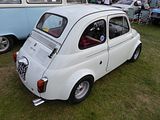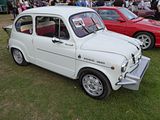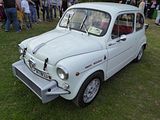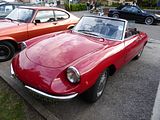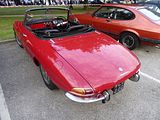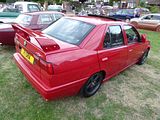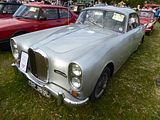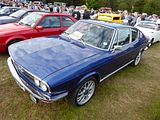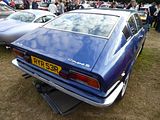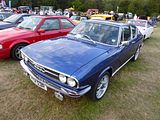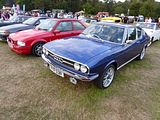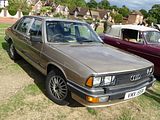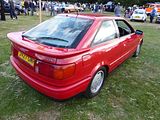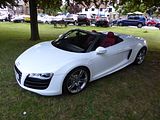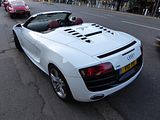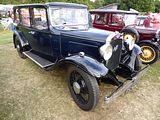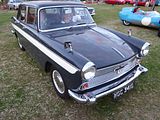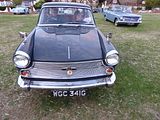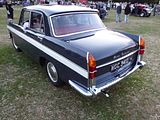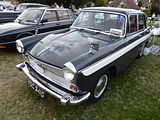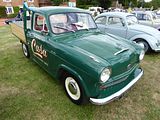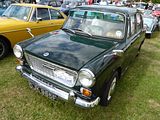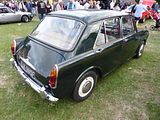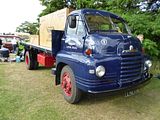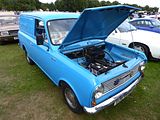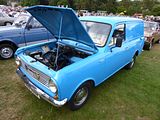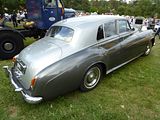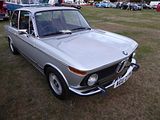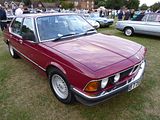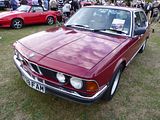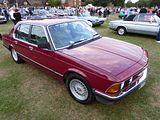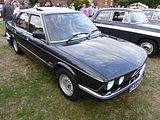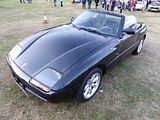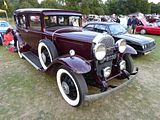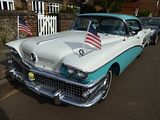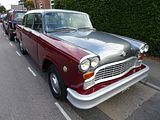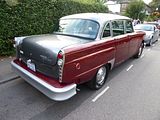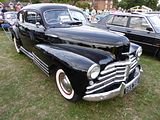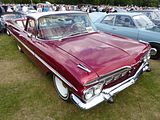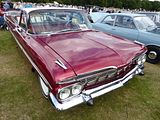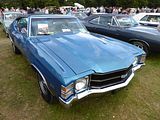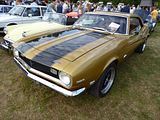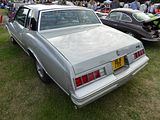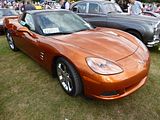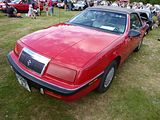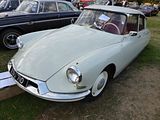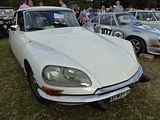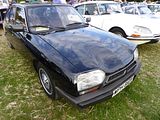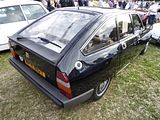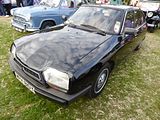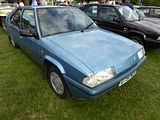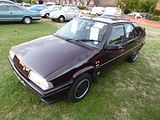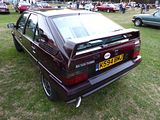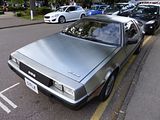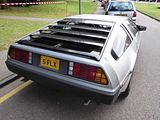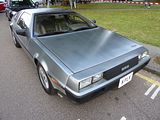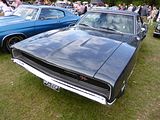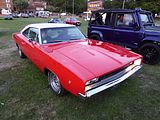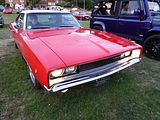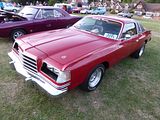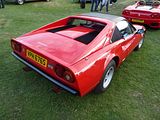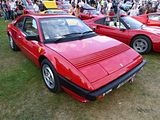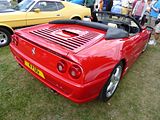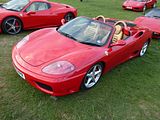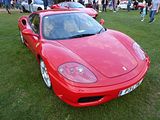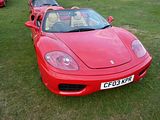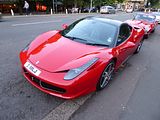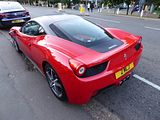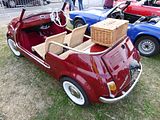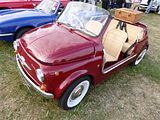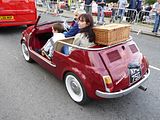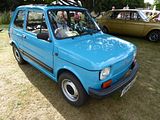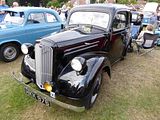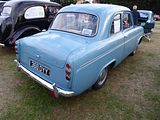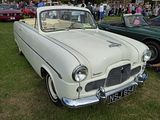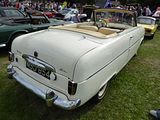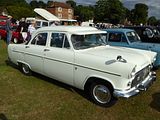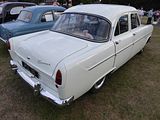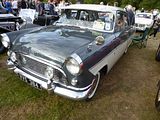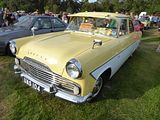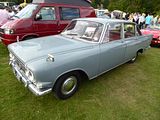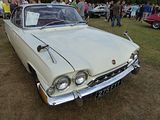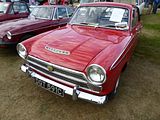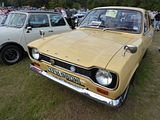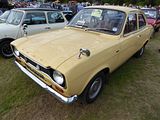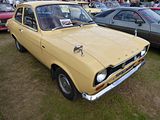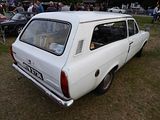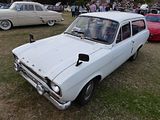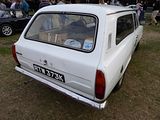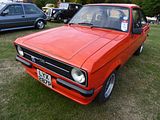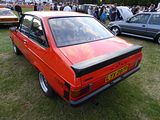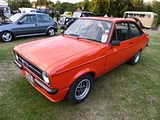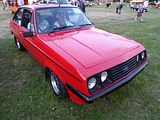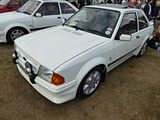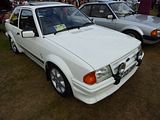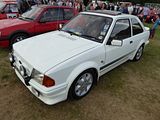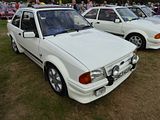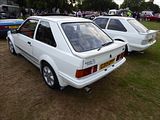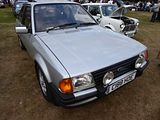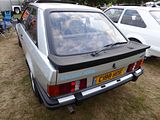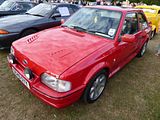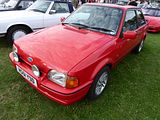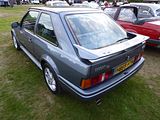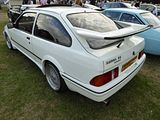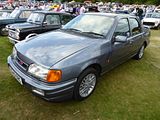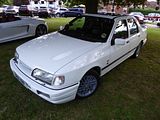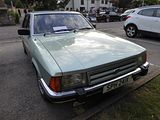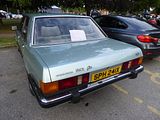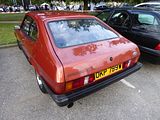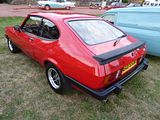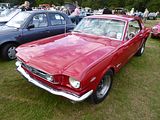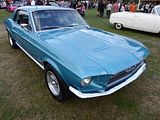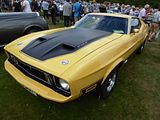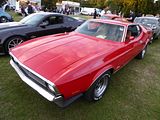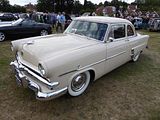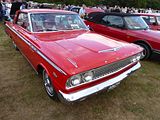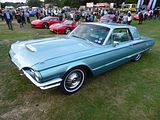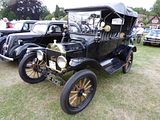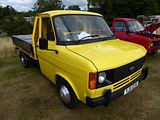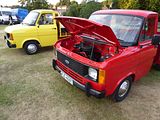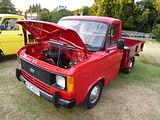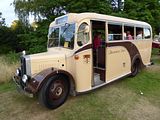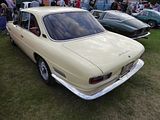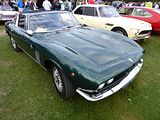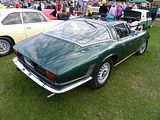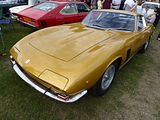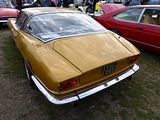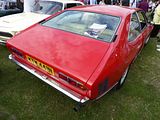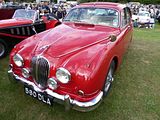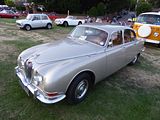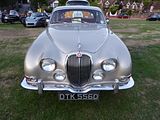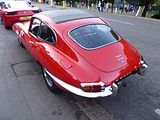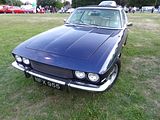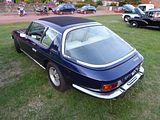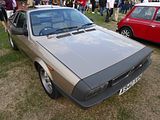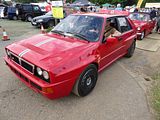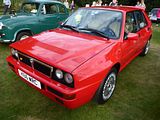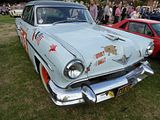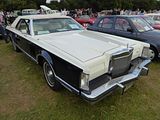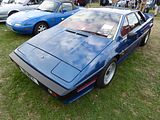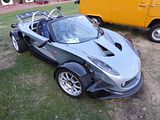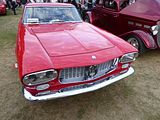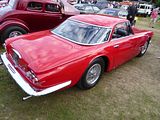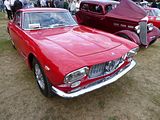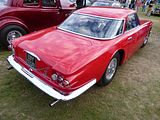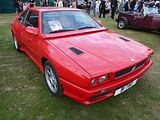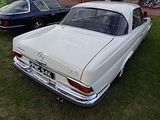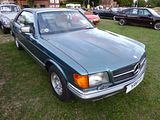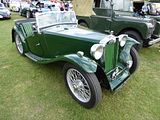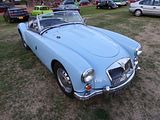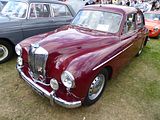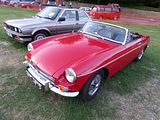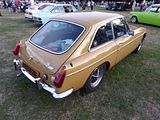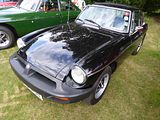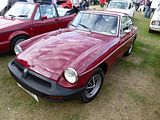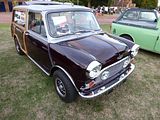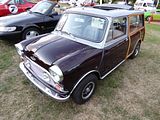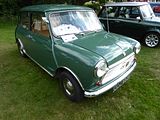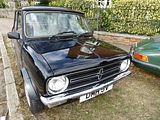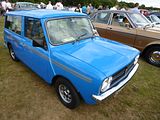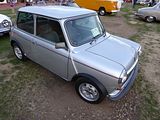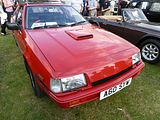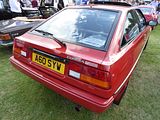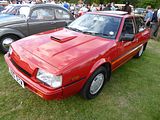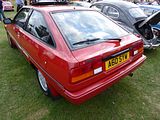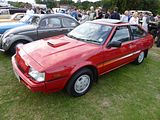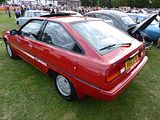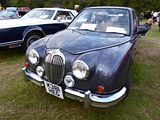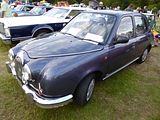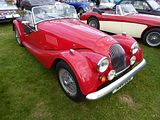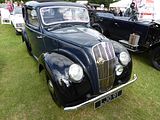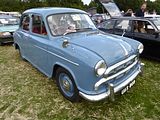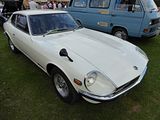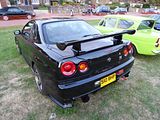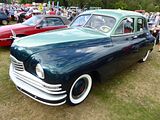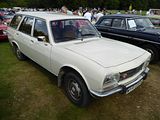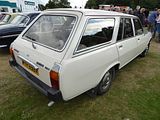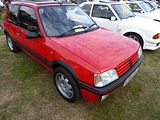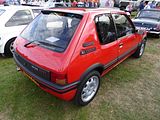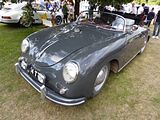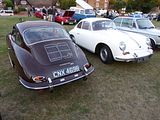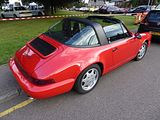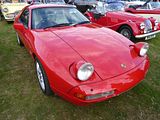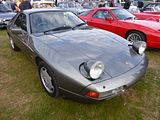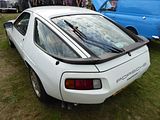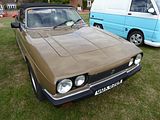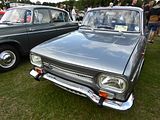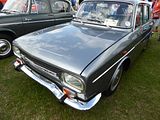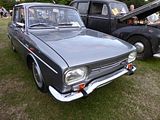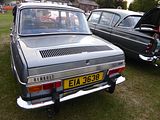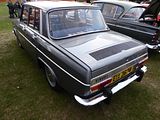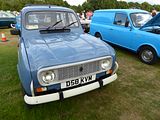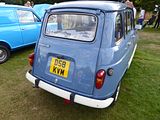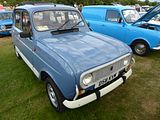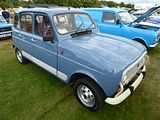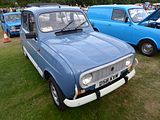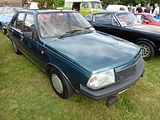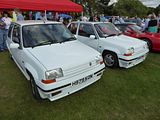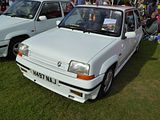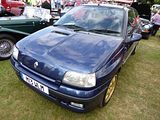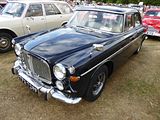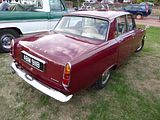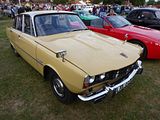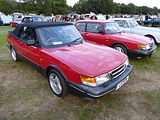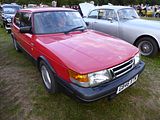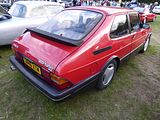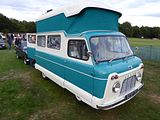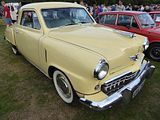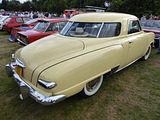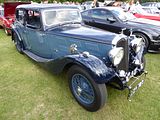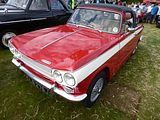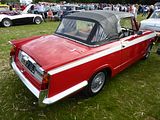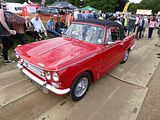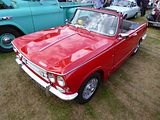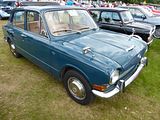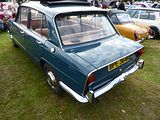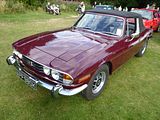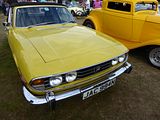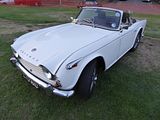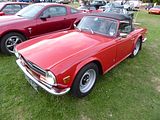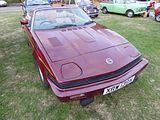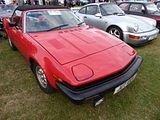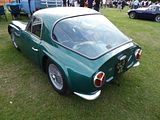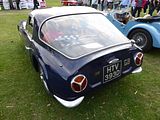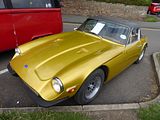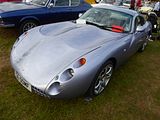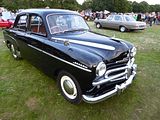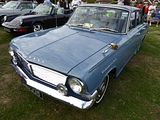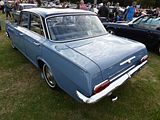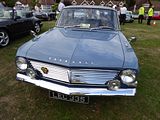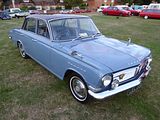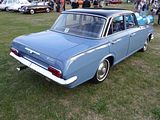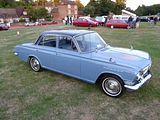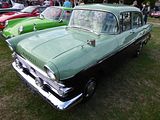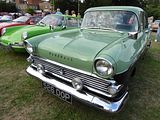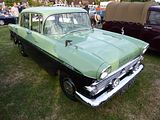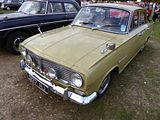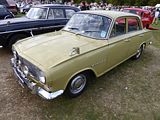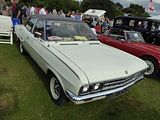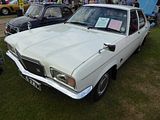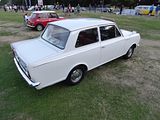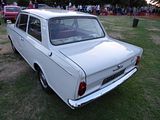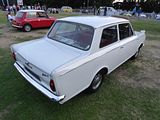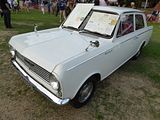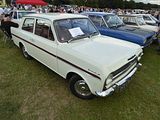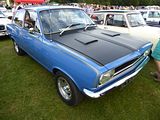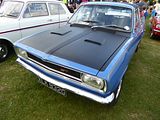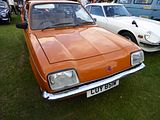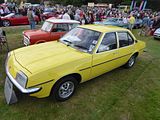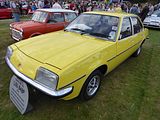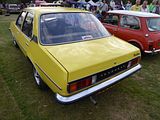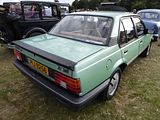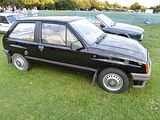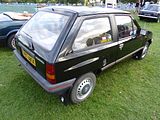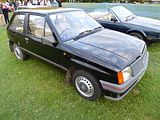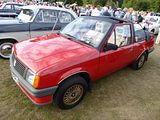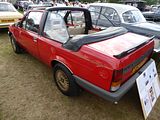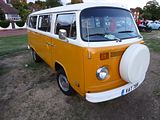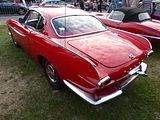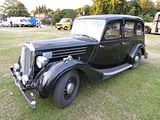Harpenden is a small country town on the border of Bedfordshire and Hertfordshire. It is situated just a few miles down the road from Luton, and the Luton Hoo Estate. To the car enthusiast, the first of these is known for the fact that it was the home of the Vauxhall, even though the reality is that no cars bearing the Griffin badge have actually been made there for some time, the plant being used solely for the production of the Vivaro van these days and it does remain the Company’s Head Quarters location. The latter, Luton Hoo, is a country estate to the south of the town, which plays host to a fantastic mid-week event called “Classics in the Walled Garden” which takes place in early July. You might have thought that this would satiate the local market for a mid-week evening event, but you would be quite wrong, as just three weeks later, Harpenden plays host to its own event, called “Classics on the Common”. Things get underway during the afternoon, so by the time most people start to arrive, at the end of the working day, the two large areas of Common, which are right in the middle of Harpenden are well populated with cars, and the crowds have built. I found this out the hard way when I attended in 2014, so for this year thought I would try to arrive that bit earlier. All seemed to be going well, as the traffic was flowing reasonably freely through the town at 4pm, when I arrived, but by the time I got to the public car parks, south of the town, they were in fact declared to be full. The local marshalls were absolutely no help in being able to describe how to get to the other parking venues which they said were allocated to the event, but at least I was able to pull back out towards the main road quite easily, whilst many were still queuing in vain. In the end, I found a space in the “pay and display” which was probably nearer to the event than the official parking, and I only had to pay £1.80 for the time until charging ceased. That left me with plenty of time to see just what was parked up. There is a strict rule that display cars have to be pre-booked, as demand for places exceeds the available space by some margin, and there is also an inviolable rule that no cars of less than 20 years old are allowed in the main display, though some lucky owners did manage to find a parking space very close by which is why the odd newer car does feature in this report. People start to depart from around 7pm, and most are gone by about 9pm, so you have to keep moving if you are to get decent photos of everything (devoid of too many people in the way of the photo – not always a realistic objective!), and the problem was compounded by the fact that it was a nice sunny evening, which meant that the shadows became more of a challenge until the sun had gone down low enough. That does mean that there are quite a few cars that I missed, but there is more than plenty in this report, many of them the sort of car that you don’t see that often, to enjoy. So, please do just that as you read on.
ABARTH
Two classic Abarths from the 1960s were here, and both were utterly fabulous to this devotee of the marque. Smaller of the two was a 595, the “entry level” version of the range, based on the Nuova 500, and also on display was a 1000TC, a model based on the larger 600 and produced as a more performant model than the 850TC which was Carlo’s first enhancement of the 600 range.
ALFA ROMEO
Two very different Alfa models were on show, both of them rare variants of relatively familiar models. Older of the pair was one of the first generation “Duetto” styled Spiders with its curvaceous boat-tailed rear end. More commonly seen with the 1600cc engine, this was 1300 Junior, a cheaper model added to the range to increase sales.
The Silverstone was a homologation special version of the 155. The most obvious difference is the large rear spoiler, which was actually supplied as a kit in the boot of the car, so it quite a few of these cars never had the spoiler attached. This one clearly did get installed.
ALVIS
This is a TE21. Sold between 1963 and 1966, the TE Series was a three litre sports saloon or drophead coupé, with a body built by Mulliner Park Ward. It was an updated version of the 1958 TD21. The body was a modified version of the TC 108G styled by Graber of Switzerland but built by Mulliner Park Ward and distinguished by having twin headlights mounted one above the other. The design was noted for its lack of bright side trim or creases moulded into the body parts. The windscreen was one-piece, curved, and not too highly sloped. The 2993 cc engine, first used in the 1950 TA 21, received a modified cylinder head and manifold which increased power to 130 bhp at 4000 rpm giving the car a top speed of 107 mph A choice of automatic or five speed gearbox made by ZF was available. Suspension was independent at the front using coil springs, with leaf springs at the rear. Disc brakes were fitted to all wheels. Recirculating-ball-type steering gear was fitted to reduce effort and power steering became optional in late 1964. Although the car was replaced by the TF 21 in 1966, the TE 21 was still in stock and “available to special order” until 1967. The TF21 was visually identical to the TE21, but had revised steering, suspension and trim details. Alvis ceased the manufacture of passenger cars in 1967.
AUDI
Three Audi models were in the main display, and two of them are ones you rarely see these days. Oldest of these was a 100 Coupe S. Launched in the autumn of 1970, so more than a year after the saloon models, the Coupe bore quite a strong resemblance to the Aston Martin DBS, though it was not styled by the same person. The Coupe S had a bored out 1.9 litre version of the 4 cylinder unit that powered the 2 and 4 door saloons, and it generated 115 bhp, giving the Coupe S quite brisk performance. Like all Audi models of the era, it was front wheel drive. It was considerably more costly than cars like the Ford Capri, so in the UK at least, sales were never that significant, so I was a little surprised to learn that nearly 31,000 of them were made over a 7 year period, though this is a tiny proportion compared to the 800,000 saloons models that were produced.
Another rare car was this Audi 200 5T. The 200 was a more luxurious version of the second generation 100. Launched in 1979, it was only offered with the 5 cylinder engine, in both fuel injected and turbo charged guises, and it had a lot of additional standard equipment compared to the 100 models, which for the UK market included opening quarter lights, electric wing mirrors, a sun roof, cruise control and heated seats. All 200’s came with automatic gearboxes, with a five-speed manual available by special order. Just 500 of the cars came to the UK before it was replaced by the very aerodynamic next generation model in 1982/3.
Final Audi to be seen was a Coupe 2.3. This is the second generation car which had the hard job of taking over from the original Quattro shaped cars, and which, although a worthy enough car, never quite hit the spot in the same way. Accordingly, you see these less often than the previous shape model these days.
Not yet even close to 20 years old, the R8 Spyder – a future classic for sure – was parked up outside the event.
AUSTIN
There were a number of Austin Sevens present, but somehow these all appear to have eluded the camera, so the oldest Austin model which I can include in this report is a 1920s Six.
Rather better known, and a lot more recent, though now 50 years old itself, is the A60 Cambridge. This was one of the most popular of the Farina designed cars which was offered from 1959 until 1971 (In Morris Oxford guise), with several different badges and subtle trim differences. In addition to the saloon and estate models, the front end was used for Van and Pickup models, and one of the latter of these was also on show.
Sitting above the A60 in the range was the Westminster. Like the Cambridge, the name was first used in the mid 1950s on a very different looking car, and when that was replaced by a new model in 1959, the name was carried over. Whereas the first Westminsters had shared the same body design as the Cambridge, but with an elongated front end to accommodate the inline six cylinder engine, for this generation, the car had a style all of its own. It was designed by Farina, and there was a clear family resemblance to the smaller models, but everything was different and larger. A facelift in 1961 along with a more powerful engine changed the designation from A99 to A110 and it is one of those later cars which was to be seen here.
When Issigonis’ second front wheel drive design, and the one he always said he was most pleased with, reached the market, it only had Morris badges on it, although a sportier MG version followed a matter of weeks later. It took a further year, until the October of 1963 before an Austin version was added to the range. This was the badge engineering era, so the differences between it and the Morris were confined to trim details of the grille, rear lights, and badges. The ADO16 range went on to become Britain’s best seller for most of the 1960s and early 1970s, but sadly rust has claimed most of them and unlike the smaller Mini, these are now rare cars. Seen here is an early Mark 1 model.
BEDFORD
This nicely presented Bedford is an example of the S Series, which were launched in the 1950s and which became known as the “Big Bedfords”, as they brought Bedford into the 7 ton range. The S series was immortalised in RL form – a four-wheel drive, high ground clearance version, as the “Green Goddess” emergency fire tender, used by the Auxiliary Fire Service until 1968, then until 2004 over 1000 were held in reserve by the Home Office for use in the event of fire-service industrial action or other serious emergencies. They were disposed of by the Home Office in 2005. Several have found new homes in African countries that lack a developed fire-fighting service, such as Kenya. The C series of 1957 was a forward-control derivative of the S series, and outwardly very similar to it. These vehicles were available in rigid and tractor units, with either petrol or diesel engines. The UK military were a huge customer for Bedford RLs using a 4.9 litre straight six petrol engine. Many RLs found their way into the armed forces of Commonwealth countries and later into civilian use. Alongside the S series trucks, the SB bus was released in 1950, and immediately became a big seller in India, Pakistan, Australia, New Zealand and Africa, as well as in the UK. The SB chassis was also used as a basis for specialised vehicles, such as mobile libraries, fire engines, and civil defence control units. The largest fleet of SB buses in the world belonged to New Zealand Railways road Services, with 1280 SB buses built between 1954 and 1981. The Bedford TK range replaced the S type in 1959, but the RL continued in production until 1969, when it was replaced by the M type.
The Bedford HA was a car derived van introduced in 1963 by Bedford, based on the Vauxhall Viva (HA) family car. It was also known as the Bedford Beagle in estate form and Bedford Roma in small campervan form. The Beagle was an officially sanctioned conversion based on the 8 cwt van, carried out by Martin Walter Ltd. of Folkestone, Kent, who also produced the larger Velox and Cresta Estate conversions for Vauxhall. The Bedford HA was extremely popular with utility companies in the United Kingdom, particularly the Post Office, British Rail, electricity boards, British Telecom, and British Gas. Many other firms such as British European Airways, DER rental, and Meals on Wheels services had large fleets as well, and it is alleged that it was the inspiration for Postman Pat’s original van. It was originally available in 6 cwt and heavier duty 8 cwt models (payloads of 670 or 900 lb. Gross vehicle weights were 2,400 and 2,615 lb respectively. The 8 cwt had a heavier rear axle, bigger tyres, and a sixth leaf in the rear springs, and it was generally better equipped, offering a number of chromed trim parts (bumpers, mirrors, etcetera) and slightly plusher interior fittings. Indeed, by 1971 the 6 cwt had been downgraded further yet, and now only came with a driver’s seat as standard, though a fold-down rear seat was available as an option. The early 1057 cc version had a lower (7.3 rather than the usual 8.5 to 1) compression ratio than the Viva saloon, producing 47.8 hp at 5200 rpm. In 1967 this was upgraded, receiving the engine of the then new HB Viva. This 1159 cc engine was essentially the same as the earlier powerplant; although net power was down to a claimed 32.2 hp at 4600 rpm. It ran on the lowest rated fuel and was fitted with a 17 mm carburettor for even better fuel economy. Later models werepowered by the 1256 cc engine, which offered 48 hp at 5400 rpm, with a small increase from 1977. As for all three generations of HAs, the compression ratio remained 7.3 to 1. For the lighter duty HA 110 there was also an ‘Economy’ version, with a CD carburettor (constant depression), a redesigned manifold, and a different camshaft. This version offered up to 30% lower fuel consumption, although power did drop to 24.4 bhp at 3800 rpm. The HA soldiered on in production for twenty years, until 1983, where it was supplanted by the short lived Vauxhall Chevette based Bedford Chevanne which was in turn replaced by the Bedford Astravan / Bedford Astramax. Despite the fact that the Vauxhall Viva upon which it was based had gone through two further model generations, the bodywork of the HA van stayed the same until its eventual discontinuation in 1983 but it did receive most of the mechanical updates from the HB and HC model Vivas.
BENTLEY
The S Type Saloon, a close relative of the Rolls Royce Silver Cloud, was first revealed in April 1955. It represented a complete redesign of the standard production car, the R Type (which had started off as the Mark VI). It was a more generously sized five- or six-seater saloon with the body manufactured in pressed steel with stressed skin construction, with the doors, bonnet and boot lid made of aluminium. The external appearance was very different, although the car still had the traditional radiator grille. Compared to the outgoing R Type, the new model had a three inch longer wheelbase, was lower of build without reducing headroom and with an enlarged luggage boot, softer suspension with electrically operated control of rear dampers, lighter steering and improved braking. The engine, still a clear descendants of the one originally used in the Rolls-Royce Twenty from 1922 to 1929, had its capacity increased to 4887cc, and a four-speed automatic gearbox was standard, with the ability to select individual ratios if desired, which was enough to give the Bentley a top speed of just over 100 mph and 0 – 60 acceleration times of around 13 seconds. Standard and from 1957, long wheelbase saloons were offered and some were sent to the coachbuilders for alternative bodies to be fitted. An upgrade in 1959, creating the S2, saw the installation of a new V8 engine, and in 1962, the S3 cars gained four round headlights. 3072 S Types were made, 145 of them with coachbuilt bodies as well as 35 of the long wheelbase cars, before the model was replaced by the new T Type in 1965.
BMW
The roads may be well populated with BMWs now, but wind the clock back to the 20 year curfew of entrants for this event and that was not the case, with the big increase in sales only just getting underway. So you don’t tend to see that many classic BMWs at events like this. Oldest BMW model type here was a late model 1602. The 02 series is the precursor to the 3 series and was produced from 1967 to 1976, overlapping its replacement for a few months. Effectively a shortened version of the “Neue Klasse” 4 door saloon model that started out as the 1500 in 1961, the more agile 2 door 1600 quickly found favour, a status which was boosted when BMW put a 2 litre engine under the bonnet and fuel injected it to give the car, the 2002 ti, a sparkling performance. The less potent models were not quite so much fun, of course, and they were fearsomely expensive (and spartan) in the UK compared to their rivals, but still found favour among discerning buyers who liked the engineering quality and road manners of these cars.
I’ve seen quite a few of the E23 7 Series this year, a model which I had assumed was more or less extinct in the UK, and this was yet another one. Aimed at the S Class Mercedes, the first 7 models were not as bulky and were rather more sporting in conception. To my eyes they had an elegance that successive generations have never managed to exceed (and in the case of one them, it fell so far short that it will go down in history as one of the more ungainly designs of the decade).
The E28 was the second generation of 5 series, though it looked very similar to the first. Despite very premium pricing and spartan levels of equipment, these cars were quite popular when new, but they have almost all disappeared, so it was nice to come across this 528i model.
There are far more E30 3 Series models around, of course, as these were the cars which really launched BMW’s sales on the growth trajectory that continues to this day. The very first cars came solely as 2 door saloons like their predecessors, but the other body styles that were added to the range found plenty of favour as well, including the very stylish Convertible, an example of which was to be seen here along with one of those 2 door 318i models.
Final BMW here was a Z1, the very striking sports car that was produced only for a short period between 1989 and 1991. The first example of the Z1 was released by BMW to the press in 1986 and later officially presented at the 1987 Frankfurt Motor Show. Initial demand was so fierce that BMW had 5,000 orders before production began. The Z1 was designed over a three-year period by an in-house division of BMW Forschung und Technik GmbH. The development of the Z1 is attributed to Ulrich Bez and his team at BMW Technik GmbH (Harm Lagaay, Alexander Pregl, Rudolf Müller, Lutz Janssen, Wolf-Henryk Menke, Dieter Schaffner, Klaus Faust, Sabine Zemelka, Patrick Ayoub and Stephan Stark). Control of the project was turned over to. Klaus Faust when Bez left for Porsche in October 1988. The BMW Z1 was used to develop and debut several technologies. Z1 designer Harm Lagaay mentioned that Z1 production helped generate patents for BMW’s high-intensity discharge lamp, integrated roll-bar, door mechanism, and underbody tray. Both the engine and the five-speed manual transmission were sourced from the E30 325i. The 2.5 litre 12-valve SOHC straight-six engine sits tilted 20 degrees to the right to accommodate the low bonnet line. The engine produces 168 hp at 5,800 rpm and 164 lb·ft of torque in its original form. The rear suspension, called the Z Axle, was specially designed for the Z1 and this was one of the first BMWs to feature a multi-link design. In the 1990s, the Z Axle would be used on a variety of BMW Group vehicles, including the E36, 3 series, and the R40 Rover 75.The chassis was specially designed for the Z1 and featured a number of innovative features: removable body panels, continuously zinc welded seams, a composite undertray, and the unusual dropped doors. Parts of the car (including the engine, gearbox, and front suspension) were borrowed from the BMW E30 325i and 325Ix, but most of the Z1’s components are unique to the model, and that had the consequence of making it expensive. The body was made from plastic and could be removed completely from the chassis. The side panels and doors are made of General Electric’s XENOY thermoplastic. The hood, trunk, and roof cover are GRP components made by Seger + Hoffman AG. The car is painted in a special flexible lacquer finish developed jointly by AKZO Coatings and BMW Technik GmbH. During the Z1s launch, BMW suggested that owners purchase an additional set of body panels and change the colour of the car from time to time. The car could actually be driven with all of the panels completely removed, similar to the Pontiac Fiero. BMW noted that the body could be completely replaced in 40 minutes, although Z1 owners have reported that this may be optimistic. The entire vehicle was designed with aerodynamics in mind. Specifically, the entire undertray is completely flat and the exhaust and rear valance were designed as integral aerodynamic components to decrease turbulence and rear lift. The front end reportedly induces a high-pressure zone just forward of the front wheels to increase front-wheel traction.The Z1 has a drag coefficient of 0.36 Cd with the top up or 0.43 Cd with it down. The doors retract vertically down into the car’s body instead of swinging outward or upward. The Kaiser Darrin was the first car to have retractable doors; they slid forward into the front wings. The inspiration for these doors came from more traditional roadsters which often feature removable metal or cloth doors. Because removable doors did not fit within BMW’s design goals, the retractable doors were installed instead. The body with its high sills, offers crash protection independent of the doors, the vehicle may be legally and safely driven with the doors up or down, although this is not legal in the U.S. The windows may be operated independently of the doors, although they do retract automatically if the door is lowered. Both the window and door are driven by electric motors through toothed rubber belts and may be moved manually in an emergency. It took a while to get the Z1 into production, by which time demand had dropped considerably, perhaps due to reduced demand from speculators. In the end, BMW only produced 8,000 Z1 models. 6,443 of these were sold in BMW’s native German market. The country to receive the second-greatest number of Z1s, Italy, received less than 7% of the total sold domestically. BMW was reportedly unable to build more than 10 to 20 Z1 vehicles each day. None were initially sold in North America, although examples have been independently imported since the car’s launch. More than half of all Z1 vehicles (specifically, 4,091) were produced for the 1990 model year. Seventy-eight Z1 vehicles were reportedly used as test mules, although most were later sold without a warranty and, presumably, at a lower price. The Z1 was available in six exterior colours and four interior colours. Most (6,177) were red, black, or green with a dark grey interior. Light yellow exterior (fun-gelb in German or fun yellow in English, with 33 examples made and cars with a red interior (38 examples made) are the rarest Z1 colours. The colours swimming pool blue and oh-so-orange were reserved for the car’s designers, Bez and Lagaay. Reportedly, some 1,101 Z1 vehicles were delivered without a factory radio installed. In these vehicles, BMWS AG installed an aftermarket Sony radio in its place. None of the Z1 vehicles were sold with air conditioning. The vehicle’s dashboard is very small and there was no room for both heat and cooling units. Some Z1 vehicles were converted using BMW E30 parts to have air conditioning, but reportedly the heater elements had to be removed. Although prices did drop from the new car cost of around £40,000, these have never been cheap cars to buy, and these days values are increasing again.
BUICK
This rather splendid machine dates from the late 1920s or early 1930s.
Special was the name that Buick used for the entry level model in their range. First applied in 1936, it was in continuous use until 1958, the date of this car. During the 1950s, US manufacturer made extensive changes to their models on an annual basis, with sufficient styling changes to make the cars look like they were completely new even when they did carry over plenty from the previous year. The 1958 models were the last of a line started in the middle of the decade, before GM replaced all their cars for 1959 with the largest fins ever (yet?) seen. Although much under the skin was shared with GM’s other brands, the Buick models always looked completely different from the more humble Chevrolet. the three venti ports had become a styling feature with the 1949 Roadmaster and they remained on the cars throughout the decade. Innovations for 1958 were the use of four headlights and there was even more chrome. The model was replaced by the leSabre in 1959.
CHECKER
Once a common sight, the Marathon was the staple of taxi fleets in New York and many other American cities for more than two decades. Indeed, with no dealers to speak of, Checker sold almost their production to fleet customers over a 22 year period. The Marathon was introduced in September 1960 for the 1961 model year, alongside with, and later superseding, the Checker Superba Custom and differing from the Superba with its better interior appointments. Marathons were produced in both four-door sedan and four-door station wagon forms, and the rare eight-door, 12-seater “Aerobus” wagon. Notably, the Marathon’s front suspension A-frames interchange with a 1956 Ford. The engines used were originally Continental-built L-head inline-sixes (OHV units for the wagons), but these were exchanged for Chevrolet sixes and small-block V8s for the 1965 model year. These continued to change as Chevrolet introduced modifications, peaking with the 1969 L-48 350 V8 which produced 300 hp In 1969, a Perkins 4.236 L diesel nonturbo engine was available as an option for all models, but for only one year. By 1973, power for the 350 had decreased to 145 hp and in 1975 catalytic converters were introduced. For 1980, the engine line-up was changed entirely, with a 3.8 litre V6 replacing the old inline unit, and a smaller 4.4 litre , or an Oldsmobile LF9 engine, 5.7 litre V8 diesel V8. With the exception of United States government-mandated 5 mph bumpers in 1974 and those ongoing mechanical changes, the Marathon remained virtually unchanged during its 21-year production run. However, Checker did comply with all safety and emissions requirements while in production. The final Marathon was manufactured in 1982, when Checker exited the automobile manufacturing business. The company continued operations for an additional 27 years producing body stampings for General Motors, Ford, and Chrysler, until January 2009, when it entered bankruptcy liquidation as a result of the downturn in the USA auto industry. The final Checkers disappeared from the streets during the 1990s, so they are a rare sighting now.
CHEVROLET
This 1941 Stylemaster De Luxe 2 Door is one of the cars that I had seen at the Luton Hoo event three weeks earlier.
El Camino 1959
1968 Chevelle SS
1968 Camaro 393
1978 Monte Carlo
More recent Chevrolet models included a C6 generation of the Corvette, and parked up outside the main event, a current Camaro SS.
CHRYSLER
After discontinuing the first generation LeBaron coupe and convertible in 1986, Chrysler released a new LeBaron for 1987, built on the J platform (a K platform derivative) and available as a coupe or convertible. The all-new LeBaron looked modern and aerodynamic compared to its boxy predecessor and was quite stylish for its day, featuring headlights hidden behind retractable metal covers and a waterfall grille, steeply raked windshield, full-width taillight lenses though only the edges actually lit up, and curved (Coke bottle) style rocker panels. The LeBaron was equipped with a trip & fuel economy computer and full instrumentation. In Mexico, these models were marketed as the Chrysler Phantom. The available engines were the stock 2.2- and 2.5 litre, naturally aspirated or turbocharged, and for the 1990 model year, a 3.0-litre Mitsubishi V6 became available, although the Mexican Chrysler Phantom R/T DOHC 16V also offered the same 2.2-litre turbo engine as used in the U.S. market Dodge Spirit R/T. For 1990, the LeBaron’s interior was refreshed, featuring an all new dashboard, gauge cluster, door panels, and center console design. All of the new components were designed to be smoother and more flowing than the comparatively boxy 1987-89 interior style, making it more in tune with the “aero” revolution of the early 1990s. The 1992 LeBaron coupes and convertibles could be ordered with a new “sport package”, which featured a monochrome appearance including body-coloured grille, accent stripe, and decklid logo. The package also included 14-inch “lace” style wheelcovers and a black strip below the taillights in place of chrome, with special blacked-out window mouldings on coupe models. In 1992 for the 1993 model year, the LeBaron received a slight facelift. The hidden headlamps of the 1987-1992 models were deleted in favour of less costly flush-mounted replaceable-bulb headlamps, new wheel styles were made available, and all models got the amber rear turn signals introduced on the deluxe 1992 models. For 1994, a passenger side airbag became standard on all models. Also new for 1994 was the “Bright LX” decor package which included a “bright” chrome grille, “bright” chrome badging, and “bright” chrome moulding inserts, as opposed to being body-coloured on the GTC. The available engines were a naturally aspirated 2.5 litre and a turbocharged 2.2 and 2.5 litre versions of Chrysler’s I4, and the 3.0 litre Mitsubishi V6 making a 141 hp in this application. The turbocharged engines were dropped from the lineup in 1992 for the 1993 model year. The coupe was discontinued after 1993. In 1994 the 3.0 was the only available engine. The convertible was discontinued after 1995, to make way for the new Chrysler Sebring coupes and convertibles, for 1995 and 1996 respectively.
CITROEN
2015 marks the 60th anniversary of the first appearance of the legendary DS. It is hard to imagine now just what a shock this futuristic design must have been when people first saw it at the Paris Motor Show, as it still appears quite modern looking even now. Of course the first cars, whilst boasting the innovation of the suspension system which gave the car its magic carpet like ride, were not blessed with a new engine, as it was not ready, so they were not quite as modern to drive as people may have hoped, but even so, Citroen could not build them fast enough to meet the initial demand. Now, 40 years after production ceased, they are much in demand, and prices for nicely restored examples are high and rising. There were two of them here, an early DS19 and a later DS21 with the swivelling headlights which turned with the steering wheel.
Citroen’s GS of 1970 was also pretty revolutionary in many respects, boasting a small capacity highly efficient four cylinder engine of just 1015cc mounted low in the chassis to give excellent handling and roadholding, and with excellent aerodynamics, a surprisingly lively performance for such a small engine in a car where you would have expected at least another 300cc. It was roomy too. The suspension gave it an excellent ride, and the lack of convention went as far as the instruments, where on left hand drive models, there was a rotating drum speedometer. What it lacked, though, was a hatchback. That was addressed when a significant facelift was applied in 1979, creating the GSA. The appearance was updated with new plastic grille and bumpers, and mechanical changes brought more power, and the option of a five speed gearbox. This is a GSA Pallas from late in the model’s life.
Replacement for the GSA came in the autumn of 1982 with the launch of the BX. Initially offered in a limited model range with a choice of 1400 or 1600cc petrol engines, over the years the range expanded with diesel and turbo diesel engines of various sizes, an estate, and more powerful models creating the GT, GTi and GTi 16 valve. There were even plans for a 4 wheel drive rally version, though these never got very far, thwarted by the abandonment of the Group B class in which the car would have competed. Much of the BX’s body was plastic, but even so, these cars have not survived in large numbers, so it was interesting to see two of them here.
DAIMLER
Perhaps the best known of classic Daimlers, the SP250 “Dart”, launched in 1959, was the last new model from the Daimler Company before its acquisition by Jaguar in 1960. It was conceived as one of a pair of models that would use a new small V8 engine of 2.5 litres that Daimler were developing in the late 1950s. Initial plans called for a saloon model, but the profit projections for the sports car were such that it was the one that was pushed forward into production. One way that it could be made ready so quickly was that it used a fibreglass body, which also had the advantage of lower tooling costs and the possibility of changing the styling more readily than if steel were used. Early cars were disappointing, with a number of teething troubles, including an engine with a propensity to overheat and doors that did not fit well, with a tendency for them to fly open thanks to undue flexing in the chassis. The final straw came when an in-house rival, the Jaguar E Type was introduced some 18 months later, offering far more attractive styling and much better performance. Although the early problems with the Dart had been solved, it was enough and the car faded from production in 1964 with just 2654 having been made, a long way short of the 3000 a year which were going to generate all those elusive profits.
This is an example of the Daimler Majestic. Launched in July 1958, it was planned to carry the new V8 engine which had been under development for some time. But it was not ready, so when the replacement for the short-lived Regency One-o-Four appeared, it still had a six-cylinder engine, but it was combined with a new three-speed Borg Warner automatic transmission, power steering and vacuum-servo assisted four-wheel disc brakes which meant that although the styling was looking a bit unfresh, it was mechanically up-to-date for its time. The heavy coachbuilt body of outdated construction on a separate chassis kept the car’s mass well above more modern designs and made it difficult to manoeuvre, despite the modern steering. The styling was already becoming outdated when the car appeared and became increasingly dated as lighter cars with monocoque construction appeared during the Majestic’s 4 year production run, so this car was not the salvation for the failing Daimler Company which would be acquired by Jaguar in 1960. The Majestic continued in production until 1962.
By the time that this Sovereign was launched, in 1969, Daimler cars were, with the exception of the DS420 Limousine, little more than Jaguars with a different grille and slightly altered trim. That does not mean that they were bad cars. Far from it, of course, as the XJ6 on which this model was based, was one of the very best luxury saloon cars available at the time. Even today it exudes elegance and class in a way that many of today’s high end models simply do not do.
DELOREAN
Does the DMC12 need any introduction? It would seem that this car will pull a crowd wherever it goes. Proof that maybe all you have to do to get real attention is to feature in a popular film like this car did!
DODGE
There were two examples of the classic 1968 Charger here. One of the “muscle cars” of the late 1960s and early 1970s, the Charger nameplate had first been seen in mid 1966, as Dodge’s answer to the Rambler Marlin and Ford Mustang. Based on the Coronet, there was huge demand for personal two door sporty cars like this, and sales were strong. That led to Doge introducing a new version in 1968, when the entire B-body lineup in the range was redesigned. The Charger moved further away from the Coronet models thanks to its new styling, which featured a double-diamond coke bottle profile with curves around the front bumpers and rear quarter panels. The rear end featured a “kick up” spoiler appearance, inspired by Group 7 racing vehicles. On the roof, a “flying buttress” was added to give the rear window area a look similar to that of the 1966-67 Pontiac GTO. The Charger retained its full-width hidden headlight grille, but a vacuum operated cover replaced the electric motor rotating headlights. The previous full-width tail lights were replaced with dual circular units at the direction of Styling Vice President, Elwood P. Engel. Dual scallops were added to the doors and hood. Inside, the interior was new with a conventional fixed rear seat replacing the folding bucket seat design. The conventional boot area included a vinyl mat, rather than the previous model’s carpeted cargo area. The centre console in the front remained, but there was no centre armrest. The tachometer was now optional instead of standard and the electroluminescent gauges disappeared in favour of a conventional design. The standard engine was the 318 cu in, 5.2 litre 2-bbl V8, until it was replaced in mid-year with a 225 cu in 3.7 litre slant-six. The 383-2 and 383-4 remained unchanged. A new high-performance package was added, the R/T (“Road/Track” with no ‘and’ between Road and Track). The R/T came standard with the previous year’s 440 “Magnum” and the 426 Hemi was optional. In 1968, the Chrysler Corporation began an ad campaign featuring a cartoon bee with an engine on its back featuring models called the “Scat Pack”. The Coronet R/T, Super Bee, Dart GTS, and Charger R/T received bumble-bee stripes (two thin stripes framing two thick stripes). The stripes were standard on the R/Ts and came in red, white, or black, but could be deleted at no extra cost. The 1968 model year Charger sales increased to 96,100, including over 17,000 Charger R/Ts. The car was little changed for model years 1969 and 1970 before an all new third generation car premiered for 1971.
This car has quite a cult following in the US, but it is practically unknown here. It is a 1978 Dodge Magnum. Produced for the 1978 and 1979 model years, the Magnum was an addition to the Chrysler line up, based on the long running Chrysler B platfor, that was sold in two forms: XE and GT. In appearance it had something of the look of a rounded off Charger, and was in response to getting a car that would be eligible for NASCAR that would be more aerodynamic, something the 1975-78 Charger was not. Styling features included four rectangular headlights behind retractable clear covers, with narrow opera windows, and an optional T-bar or power sunroof. The Magnum was well equipped with power steering, brakes and seats; the suspension included Chrysler’s standard adjustable, longitudinal torsion bars, lower trailing links, and front and rear anti-sway bars. The base engine was the 318 in³ V8 with Lean Burn, while two and four-barrel carburettor 360 and 400 V8s were also available; weight was nearly 3,900 lb. The 400 was dropped from the option list in 1979 as Chrysler stopped production of big-block V-8’s in production cars at the end of 1978. A performance model, the “GT” was available with the 400 V8 in 1978 and the “E58” police interceptor (360 V8-195 HP) engine in 1979 along with HD suspension, special axle, special “GT” badging and a “turned metal” dash applique. Technology was advanced for the time with an onboard spark control computer from inception, electronic ignition, and a lockup torque converter. The Magnum name was discarded quickly in favour of the Mirada, a smaller car that was also shared an all new body with the Chrysler Cordoba. The Magnum has something of a cult following today, with several clubs and enthusiasts who are dedicated to the recognition and preservation of Chrysler’s “last B-body”. In 1979, they made 3,704 Dodge Magnums with the T-Top.
FERRARI
The Ferrari Owners Club had a sizeable assembly of cars here, some of which would seem to have bypassed the 20 year old rule. Attracting most attention, not surprisingly, was an F40
The other Ferraris present were all V8 models, with examples of many of the different types produced over the past 30 years. Oldst of these was a 308 GTS. This was joined by a Mondial Qv, an F355 Spider, a duo of 360 Modena Coupe and Spider and the recently superceded 458 Italia and Spider.
FIAT
The regular Nuova 500 attracts lots of interest wherever this cute little car appears these days, but that is a mere nothing compared to the attraction posed by this model, a 500 Jolly. Born of FIAT boss Gianni Agnelli’s wish for open motorised transport from his massive yacht, the Agneta, during port stops along the Mediterranean coast, a design for an open bodied 500 was produced by Ghia. The finished car was dubbed ‘Jolly de Plage’, or Joker of the Beach. Based on the regular Nuova 500 with its unitary construction, these cheeky little cars boasted featured independent suspension, a four speed synchronized transmission, with the engine at the rear. The 479cc air-cooled twin was hardly a performer, but light construction (and mostly low-speed intended uses) made the package work well. There was a roof that was more like a beach umbrella, and the seats were wicker, as can be seen in this car, so these cars were certainly aimed at places where sunshine was on the menu. The Jolly found favour as courtesy transport for patrons of luxury hotels and golf courses, such as Catalina Island off the coast of California, where a fleet of 32 Jollys provided taxi service or, as initially intended, for use ashore after one had docked one’s yacht on the Italian or French Riviera. Lacking doors and equipped with waterproof wickerwork seats, the Jolly was only practical as leisure transport, thus confirming its owner’s status as someone who could afford a car ‘just for fun’ (indeed, the Jolly was roughly twice the price of the base model it was derived from). Among the list of Jolly owners in the day are jet setters such as Aristotle Onassis, Yul Brynner, John Wayne, Grace Kelly, Henry Ford II, and even President Lyndon Johnson. As well as the 500-based models, Fiat 600s and even the Multipla were also converted.
Fiat replaced the Nuova 500 with the 126 in 1972, and the model never quite found the same level of enthusiasm in the market. Partly that was because it remained a somewhat basic machine and buyer’s expectations had moved on. Fiat tried to address this when they launched a better equipped version, the De Ville in 1977. A larger 652cc engine gave it slightly less marginal performance, but this remained a car with minority appeal. Now, though, there are plenty of people who see a well presented car like this one through somewhat nostalgic eyes.
FORD
Reflecting the long-running popularity of the Blue Oval, even though this event was taking place on rival Vauxhall’s home turf, there were lots of classic Ford models on show, from both sides of the Atlantic. Ford really started to grow market share in the UK when they extended their range downwards with models aimed at the family motorist, designed in the UK for UK tastes. Sometimes called the Eight, the Model Y was the first Ford designed in Europe. It was powered by a 933 cc, 8 hp Ford sidevalve engine, and was available in two and four-door versions. The suspension was by the traditional Ford transverse leaf springs front and rear and the engine drove the rear wheels through a three-speed gearbox which, right from the start, featured synchromesh between the top two ratios. The maximum speed was just under 60 mph and fuel consumption was 32 mpg. Even by the standards of the time, the car, like its major competitor the Austin 7, was found noteworthy for its almost unbelievable lack of brakes. In June 1935 a reduced specification two-door model was the only closed-body car ever to sell in Britain for just £100, a price it held until July 1937. It was replaced by the 7Y in 1938, which following a minor facelift became the Anglia. Production resumed after the war, along with a four door version, the Prefect. When these models were replaced by a much more modern design in 1953, the design lived on in the E103 Popular. It was powered by a Ford Sidevalve 1172 cc, 30 bhp four-cylinder engine, and was very basic. It had a single vacuum-powered wiper, no heater, vinyl trim, and very little chrome; even the bumpers were painted, and the bakelite dash of the Anglia was replaced by a flat steel panel. The Popular 103E differed visually from the Anglia E494E in having smaller headlights and a lack of trim on the side of the bonnet. Early 103Es had the three spoke banjo type Anglia/Prefect steering wheel as stocks of these were used up, but most have a two spoke wheel similar to the 100E wheel but in brown. Early Populars also had the single centrally mounted tail/stop-lamp of the Anglia, but this changed to a two tail/stop lamp set up with the lamps mounted on the mudguards and a separate number plate lamp. This car proved successful because, while on paper it was a sensible alternative to a clean, late-model used car, in practice there were no clean late-model used cars available in postwar Britain owing to the six-year halt in production caused by the Second World War. This problem was compounded by stringent export quotas that made obtaining a new car in the late 1940s and into the early 1950s difficult, and covenants forbidding new-car buyers from selling for up to three years after delivery. Unless the purchaser could pay the extra £100 or so for an Anglia 100E, Austin A30 or Morris Minor, the choice was the Popular or a pre-war car. 155,340 Populars were produced. Seen here were examples of the E494 Anglia and the related E93 Popular.
Ford had a habit of keeping a model in production alongside its replacement, so when the 105E Anglia was launched in the autumn of 1959, the previous bodyshape stayed in the range, in 4 door guise as the 107E Prefect and in stripped out bottom of the range entry level new car motoring, the 100E Popular, as seen here. In 1960, the manufacturer’s recommended retail price of £494 was equivalent to 26 weeks’ worth of the average UK wage. The £100 charged in 1935 for the Model Y and the £1,299 charged for the Ford Escort Popular in 1975 both also amounted to 26 weeks’ worth of average wage for the years in question. In the 1950s, however, the country had been undergoing a period of above average austerity: in 1953 the car’s £390 sticker price represented 40 weeks’ worth of the average UK wage. The 100E was powered by a strengthened 1172 cc sidevalve engine producing 36 bhp which gave it a top speed of 69.9 mph, acceleration from 0–50 mph in 19.6 seconds and a fuel consumption of 33.2 mpg. The brakes were now hydraulic with 8 in drums all round. The new Popular offered 1,000 mile service intervals, like its predecessor, but it only had 13 grease points as against its predecessor’s 23, and 28 for the pre-war cars. The basic model stripped out many fittings from the Anglia but there was a large list of extras available and also a De Luxe version which supplied many as standard. 126,115 Popular 100Es were built. In later years, these cars became popular as hot rods since the late 1950s when people started drag racing them due to their lightweight construction. This practice started in the United States but became the definitive British hot rod, which it still is today.
There were a number of the larger models from the 1950s and 60s here as well. Representing the Mark 1 range was a Zephyr Convertible, as well a couple of the replacement Mark 2 Consul Lowlines and the plusher six cylinder Zodiac and a Mark 3 Zodiac model as well.
The Consul Capri was a two door version of the Consul Classic saloon. Intended to introduce some glamour into the rather staid Ford range, it did not really hit the spot, as even with the 1500GT engine under the bonnet, it was not much fun to drive, something that the Cortina would correct. The Classic and Capri had been long in gestation, designed before the 105E Anglia that was launched a couple of years prior to this model, so it was rather old fashioned at birth, and it had a short life, produced only for three years.
Lone representative of the Cortina, at least which my camera and I saw was a Mark 1 GT model. A sporting top of the range, the GT was launched in the Spring of 1963, a few months after the more basic 1200 and 1500cc cars, it had a revised version of the pre-cross-flow 1500cc engine which generated 78 bhp, thanks to a revised breathing and a twin choke carburettor. It also had revisions to the suspension, and was noticeably brisker than the standard 60 bhp 1500cc car.
There were a number of Escort models from the first three generations. Representing the Mark 1 were two decidedly non-sporting versions, with a well cared for 1100L and a rather well used looking Estate on show. Both attracted lots of interest, as these cars used to be much in evidence on our streets, but are rare now, with many of the remaining shells used to create replica sporting and rally cars.
The Mark 2 cars were both sporting models, the short lived Mexico and an example of the RS2000, a car which had its own distinctive front end with twin headlights and a more aerodynamic profile.
It was also sporting examples representing the third generation car, the first front wheel drive Escort. This model, sold between 1980 and 1990 underwent a major facelift in early 1986, and there were cars from both before and after this time. Two of them were the top of the range RS Turbo cars, sold only for a short while in pre facelift guise, as well as the commercially more significant and bigger selling XR3i.
These days you are more likely to see a Cosworth version of the Sierra than any of the regular models which were among Britain’s best sellers for 10 years, and that proved to be the case here, with both a three door Sierra RS Cosworth and the later four door Sapphire Cosworth on display.
This facelifted Mark2 Granada Ghia 2.8 was not in the main event, but parked up on the street across the road from the Common. The Granada was a good looking car at launch in 1977, though many will say that the 1981 facelift did not improve things, with larger bumpers and the new grille spoiled the purity of the original design. Even so, it was popular, and the 2.8 Ghia – with or without the fuel injection – was the aspirational car for many a senior manager and board member.
The only Capri models that I managed to photograph were Mark 3 models. They came from opposite ends of the range, with an entry level Capri 1.3L contrasting with the 3.0S on non standard wheels. The latter was the version that everyone aspired to, and whilst it was not expensive for what it was, it was still beyond the means of many. Now, though, you see 2 and 3 litre models far more often than the 1.3 models.
There were several American Fords here, too. Best known were the array of Mustangs. I missed getting a photo of the genuine Shelby 350H ex Hertz rental car that was present, but I did find this array of models, all of them from the first generation of the Pony car that ran from 1964 to 1974, showing the evolution of the model, with changes especially evident at the front end as the 1960s progressed, and them the more significant changes into the 1970s with the larger fastback bodies.
Pre-dating these by some years was this Customline V8 2 door
1960s American Fords were represented by a 1965 Galaxie 2 dr Hardtop and a Thunderbird from the generation affectionately known as the “Squarebird” thanks to its straightened out rather rectangular lines.
Oldest Ford by some measure was this rather impressive Model T
Commercial vehicles tend to have a far harder life than passenger cars, and hence their survival rates are considerably lower, so the workhorses of our roads just disappear. There have been Transits for 50 years now, with the vehicle just achieving its half century, but you don’t see the first generation model very often. That was not the case here, where a couple of beautifully restored Dropside Pickup models were on show.
GUY
Bus
ISO
Not many Iso cars were ever sold, and few of them came to the UK, so to see one is rare., but to see four, at an event like this is very unexpected. Only four different models were offered during the time that Iso made cars, and three of these types and been brought along by members of the Iso Owners Club, who had managed to park all their cars together in a group. Originally founded in Genoa in 1939, but transferred to Bresso in 1942 by Renzo Rivolta, an engineer and the heir of industrialists, the Iso Rivolta company was initially named ‘Isothermos” and manufactured refrigeration units before World War II. After the Second World War, the company reopened its doors, completely changing its activity. In 1948 it began to build motorcycles, scooters and motocarriers (three-wheeled transport scooters/motorcycles). Among the most famous are the Furetto (1948), ‘Isoscooter (1950),’ Isocarro (1951), ‘Isomoto (1954) and’ Isosport (1953). Accordingly, the business was refounded as Iso Autoveicoli S.p.A. in 1953 to reflect the production of motorized transport. In the mid-1950s, Rivolta started to develop a miniature car for two persons and front entrance, initially with only three wheels, later, for reasons of stability, with four wheels (the two on the rear very close together): the Isetta Bubble Car. About 20,000 of the bubble cars were built at the Rivolta works near Milan. Starting in 1954, Isetta was licensed to automobile manufacturers in several countries: France (by VELAM), Spain, Great Britain and Brazil (by Romi). The most successful, however, was the German Isetta built by BMW. The BMW-Isetta went on to dwarf the production volumes of Rivolta and fulfilled the dream of mobility in post-war Germany. About 130,000 had been sold by 1962. That success encouraged Rivolta to become more ambitious, and together with engineer Giotto Bizzarrini, designer Giorgetto Giugiaro and chassis builder Bertone, Renzo Rivolta began developing the Iso Rivolta IR 300, which was first presented at the Torino Show of 1962. It was an elegant 2 + 2 Coupé with well-balanced technical components and outstanding driving performance. It had a 5.4 litre V8 Chevrolet Small-Block engine, the transmission came from General Motors in Detroit, and the de Dion suspension and four-wheel disc braking system came from the large Jaguars of the time. This concept was maintained for almost all production cars of Iso. The cars sold steadily. but in small numbers. One of these models was on show here.
Probably the best known Iso model is the Grifo, an elegant 2 + 2 Coupe which featured a low-slung, sporty berlinetta body by Bertone. After Bizzarrini left the project, this prototype formed the basis for his own Bizzarini 5300 GT. The Grifo Prototype was further refined by Iso, receiving a reworked, less aggressive and more luxurious body in the process, and went into production in 1965. The Grifo was powered by Chevrolet´s 5.4 litre V-8 producing either 300 or 350 hp. In 1966 a convertible version of the Grifo was shown, but never reached production. Starting in 1968 the Grifo was also available with Chevrolet’s 7 litre big-block V-8; this version was easily recognised by the broad air inlet on the hood. Later-day Grifos, the Series II, featured concealed headlights and a slightly modified front area. Seen here are examples of an early Grifo, and one of the Series 2 models, Barry Twitchell’s stunning Champagne metallic car which was the 1971 Earls Court show car. This one appears at quite a few events following an extensive and lengthy restoration that was outlined in an article in Classic and Sports Car magazine soon after the work was finished.
Renzo Rivolta died in 1966, and his son, Piero, took over as managing director. Under Piero’s leadership, Iso built the limousine Fidia, “the fastest four seats on wheels” with body by Ghia, the Grifo 7 litre and the 2 + 2 fastback Coupé Lele, an example of which was also seen here. This car was launched in 1969. It had a body designed by Bertone and was intended as the successor to the IR 300. At the start of 1973 the Rivolta family ceded the business to an Italian American financier named Ivo Pera who promised to bring American management know-how to the firm. The business was again renamed to Iso Motors, just before fading rapidly into obscurity, going bankrupt in 1974, only 1700 Iso Gran Turismos had been built in those ten years. That meant that the Lele was the last new design offered. Styled by Bertone, there was little wrong with the looks of the car, but build quality was patchy and the large V8 engine was thirsty so when the fuel crisis of 1974 made such cars a liability, sales reduced to next to none, and this proved the deathknell for the marque.
JAGUAR
There were surprisingly few Jaguar models in the event. The only two that I recall seeing were an example of the very popular Mark 2, and the later S Type, and then as I was walking back to my car, I came across a Series 1 E Type parked up on the side of the road.
JENSEN
The Interceptor was a replacement for the rather gawky looking CV8. After a false start when a car with the same name was shown in 1965, which received a massive “thumbs down”, Jensen went to Italy to find a new stylist for another attempt. They ended up with Carozzeria Touring, who produced a stunning looking grand tourer which, although sharing some styling cues with other models that they had designed, had a style all of its own, and they then approached another Vignale, to build the bodies before they would be shipped back to West Bromwich for final assembly. As with the CV8, motive power came from a large Chrysler V8 engine, which gave the car effortless performance, and a somewhat prodigious thirst. The original specification included electric windows, reclining front seats, a wood rimmed steering wheel, radio with twin speakers, reversing lights and an electric clock. Power steering was included as standard from September 1968. The Mark II was announced in October 1969, with slightly revised styling around the headlamps, front grille and bumper and revised rear lights. The interior was substantially revised in order to meet US regulations, and air conditioning was an option. The Mark III, introduced in 1971, revised the front grille, headlamp finishers and bumper treatment again. It had GKN alloy wheels and air conditioning as standard, and revised seats. It was divided into G-, H-, and J-series depending on the production year. The 6.3 litre engine was superseded by the 7.2 litre in 1971. A Convertible version was premiered in 1974,. but just 267 were built, and then in 1975 a Coupe model was shown, effectively a fixed roof version of the Convertible, just 60 of which were made as by this time, the company had fallen on hard times due to the then world-wide recession, and massive and costly reliability problems with its Jensen-Healey sports car. It was placed into receivership and the receivers allowed production to be wrapped up using the available cache of parts. Production of the Interceptor ended in 1976. Enthusiasm for the car remained, though, so in the late 1980s, a group of investors stepped in and re-launched production of the Interceptor, as the Series 4, back as a low-volume hand built and bespoke affair, marketed in a similar way to Bristol, with a price (£70,000 and more) to match. Though the body remained essentially the same as the last of the main production run of series 3; the engine was a much smaller Chrysler supplied 5.9 litre unit which used more modern controls to reduce emissions comparatively and still produce about 230 hp. In addition, the interior was slightly re-designed with the addition of modern “sports” front seats as opposed to the armchair style of the earlier models, as well as a revised dashboard and electronics. The then owner sold up in 1990 to an engineering company believed to be in a stronger position to manufacture the car which lasted until 1993 with approximately 36 cars built, and while work commenced on development of a Series 5 Interceptor, once again receivers were called in and the company was liquidated. Even that was not quite the end of the story, as the Jensen specialist based at Cropredy Bridge has made a business out of rebuilding original Interceptors using modern components, with a General Motors supplied 6.2 litre LS3 engine and transmission from a Chevrolet Corvette. In May 2010, Jensen International Automotive was set up, with the financial backing and know-how of Carphone Warehouse founder and chairman Charles Dunstone who joined its board of directors. A small number of Jensen Interceptor Ss, which had started production under a previous company, are being completed by Jensen International Automotive (JIA), in parallel with JIA’s own production of the new Jensen Interceptor R; deliveries of the latter started at the beginning of 2011.
LANCIA
The Beta Monte Carlo had a long gestation period. First conceived in 1969, with a a final design completed by 1971 by Paolo Martin at Pininfarina, what was initially known as the Fiat X1/8 Project, was originally designed as Pininfarina’s contender to replace Fiat’s 124 Coupe, but it lost out to Bertone’s cheaper design, which became the Fiat X1/9. Rather than scrap the proposal completely, it was developed further, when Fiat commissioned Pininfarina to build a 3.0 litre V6 mid-engined sports car. An X1/8 chassis was used as the start point, and developed for the first time in-house by Pininfarina and not based on any existing production car. Due to the 1973 Oil Crisis, the project was renamed X1/20 and updated to house a 2.0 litre engine. The first car to be made out of the X1/20 Project was the Abarth SE 030 in 1974. The project was passed to Lancia, and the road car was launched at the 1975 Geneva Motor Show as the Lancia Beta Montecarlo. It was the first car to be made completely in-house by Pininfarina. Lancia launched the Montecarlo as a premium alternative to the X1/9, with the 2 litre twin cam engine rather than the X1/9’s single cam 1300. Both used a similar, based on the Fiat 128, MacPherson strut front suspension and disc brakes at both front and rear. Lancia Beta parts were limited to those from the existing Fiat/Lancia standard parts bin, the transverse mount version of the Fiat 124’s twin cam engine and the five speed gearbox and transaxle. Montecarlos were available as fixed head “Coupés” and also as “Spiders” with solid A and B pillars, but a large flat folding canvas roof between them. Sales were slow to get started, and it soon became apparent that there were a number of problems with a reputation for premature locking of the front brakes causing particular alarm. Lancia suspended production in 1979 whilst seeking a solution, which meant that the car was not produced for nearly two years. The second generation model, known simply as Monte Carlo now, was first seen in late 1980. The braking issue was addressed by removing the servo, as well as few other careful mechanical tweaks. The revised cars also had glass panels in the rear buttresses, improving rear visibility somewhat, and there was a revised grille. In the cabin there was a new three spoke Momo steering wheel in place of the old two spoke one, as well as revamped trim and fabrics. The engine was revised, with a higher compression ratio, Marelli electronic ignition and new carburettors which produced more torque. It was not enough for sales to take off, and the model ceased production in 1982, although it took quite a while after that to shift all the stock. Just under 2000 of the Phase 2 cars were made, with 7798 Montecarlos made in total.
There were a couple of examples of what must be Lancia’s best known, and best loved car, the Delta Integrale. It is sad that the company that once produced such a legend has struggled not just to replace it with anything which gets even vaguely close to having the same appeal, but is now facing a sad and inglorious end after a disastrous venture seeing the brand offering a mix of rebadged Chrysler products and their own gawky Ypsilon and third generation Delta.
LAND ROVER
Old Land Rovers have a huge following, so this Series 1 107 Station Wagon was a popular vehicle during the evening. Originally the Land Rover was a single model offering, which from 1948 until 1951 used an 80″ wheelbase and a 1.6-litre petrol engine producing around 50 bhp. The four-speed gearbox from the Rover P3 was used, with a new two-speed transfer box. This incorporated an unusual four-wheel-drive system, with a freewheel unit (as used on several Rover cars of the time). This disengaged the front axle from the manual transmission on the overrun, allowing a form of permanent 4WD. A ring-pull mechanism in the driver’s footwell allowed the freewheel to be locked to provide more traditional 4WD. This was a basic vehicle: tops for the doors and a roof (canvas or metal) were optional extras. From the beginning it was realised that some buyers would want a Land Rover’s abilities without the spartan interiors, so in 1949, Land Rover launched a second body option called the “Station Wagon”, fitted with a body built by Tickford, a coachbuilder known for their work with Rolls-Royce and Lagonda. The bodywork was wooden-framed and had seating for seven people. Tickford was well equipped in comparison with the standard Land Rover, having leather seats, a heater, a one-piece laminated windscreen, a tin-plate spare wheel cover, some interior trim and other options. The wooden construction made them expensive to build. The Tickford was taxed as a private car, which attracted high levels of Purchase Tax unlike the original Land Rover. As a result, fewer than 700 Tickfords were sold, and all but 50 were exported. Land Rover continued to evolve the model, so in 1952 a larger 2.0-litre petrol engine was fitted. This engine has Siamese bores, meaning that there are no water passages for cooling between the cylinders. During 1950, the unusual semi-permanent 4WD system had been replaced with a more conventional setup, with drive to the front axle being taken through a simple dog clutch. Around this time the Land Rover’s legal status was also clarified. The Land Rover had originally classed as a commercial vehicle, meaning it was free from purchase tax, but this also meant it was limited to a speed of 30 mph on British roads. After an appeal to the Law Lords after an owner was charged with exceeding this limit, the Land Rover was classified as a “multi-purpose vehicle” which was only to be classed as a commercial vehicle if used for commercial purposes. The 1954 model year brought major changes. The 80″ wheelbase model was replaced by an 86″ model, and a 107″ “Pick Up” version was introduced. The extra wheelbase was added behind the cab area to provide additional load space. In mid-1954 the “spread bore” petrol engine was introduced allowing better cooling between the cylinders. This had been introduced in the Rover car the year before. The engine was modified again in 1955 sometimes known as the ‘later’ spread bore. 1956 saw the introduction of the first five-door model, on the 107″ chassis known as the “Station Wagon” with seating for up to ten people. The 86″ model was a three-door, seven-seater. The new station wagons were very different from the previous Tickford model, being built with simple metal panels and bolt-together construction instead of the complex wooden structure of the older Station Wagon. They were intended to be used both as commercial vehicles as people-carriers for transporting workmen to remote locations, as well as by private users. Like the Tickford version, they came with basic interior trim and equipment such as roof vents and interior lights. It is one of these that is seen here.
LINCOLN
This 1954 Lincoln Cosmopolitan will be familiar to regular readers of “Classic and Sports Car”, as this very car, which belongs to writer Julian Balme, features in the “Our Cars” pages from time to time. One of many in Julian’s fleet, he has owned it for nearly a quarter of a century, but I think this is the first time I have seen it in the metal. Julian himself spent most of the evening standing by the car, talking to people, but creating quite a challenge for the photographer. Eventually, he moved away and I was able to get a clear shot of the car.
Continental Mark V 1979
LOTUS
Esprit Turbo
I’m not quite sure how this one had got an official entry, as by my reckoning, it is not yet 20 years old. The 340R is effectively a special edition of the Lotus Elise, a model which is only just about to celebrate its 20th anniversary. Just 340 of these were built, in 2000, and all were sold before they were manufactured. It used a custom built bodyshell with no roof or doors. All the cars came with a silver and black colour scheme. They used a tweaked version of the familiar Rover K-Series engine called VHPD (Very High Power Derivative) used in the regular Elise, producing 177 bhp at 7800 rpm and 127 ft·lb of torque at 6750 rpm as standard, or 187 bhp at 7500 rpm and 139 ft·lb at 5600 rpm with optional Lotus accessories. Weighing just 700kg, this was sufficient to give the car a 0 – 60 time of just 4.4 seconds. Special A038R tyres were developed for the 340R in collaboration with Yokohama. Whilst it is road-legal in the UK, most of the surviving cars are used for racing, track use, or demonstrations
MASERATI
Probably the most valuable car on show was this Allemano-bodied 5000GT, which belongs to Stephen Dowling. The 5000GT came about as the result of a commission by the Shah of Persia in 1958 for Maserati to produce the “fastest car in the world”. Taking the engine from the 450S racer, Maserati tuned it down a bit, and working with Touring, built a chassis which was sent to Allemano for clothing in a distinctive body, the 5000GT. 33 more were made, with bodies by Bertone, Frua, Ghia, Michelotti and PininFarina.
In keeping with Maserati tradtion, the Shamal is named after a wind, in this case a hot summer wind that blows in large areas of Mesopotamia. My favourite of the Biturbo generation Maserati models, it was introduced on 14 December 1989 in Modena, when Maserati president and owner Alejandro de Tomaso showed it to the press, it was the last model announced under the De Tomaso ownership, as in January 1990 half of Maserati was acquired by Fiat S.p.A.. Sales began in 1990. The Shamal was designed by Marcello Gandini, of Bertone fame. Clearly based on the Biturbo, as you can see in the doors, interior, and basic bodyshell, all of which were carried over from the Biturbo. Gandini’s styling signature is visible in the slanted profile of the rear wheel wheel arch, also present on the fourth generation Quattroporte IV and first seen on the Lamborghini Countach. Nonetheless, the Shamal has a look all of its own, with the centre pillar wrapping around the cabin as a roll bar, always finished in black, a distinguishing characteristic of the Shamal. The name “Shamal” appears on either side of the central pillar in chrome lettering. The car has alloy wheels, a small rear spoiler and a blacked-out grille with chrome accents. Another defining feature of the Shamal are its numerous headlamps in individual housings: outer round Carello low beams of the then-new projector type, inner rectangular high beams, combined indicators and position lamps in the bumper, and two pairs of square lights in the lower grille—fog lamps and driving lamps. The two-seat interior of the Shamal features extended leather seat cushions, temperature control and the famous Maserati oval clock, which is situated in the centre of the dashboard. The gear lever is finished in elm. While built for comfort as well as performance, the Shamal was not as luxuriously appointed as the similar Maserati Ghibli II. The Shamal used a traditional front-engine, rear-wheel-drive layout and an all-steel unibody construction. Suspension was by MacPherson struts upfront and semi-trailing arms at the rear. All Shamals were equipped with an adaptive suspension developed by Maserati together with Koni. The system varied the damping rates, based on road conditions and the level of comfort desired. It was powered by an AM 479 3,217 cc square (bore and stroke 80 mm or 3.1 in) V8 engine, with two overhead camshafts per bank, and four valves per cylinder. It was twin-turbocharged with two IHI turbines and intercoolers, and equipped with a Marelli IAW integrated electronic ignition and fuel injection ECU per cylinder bank. The engine put out 325 PS at 6,000 rpm and 430 N·m (320 lb·ft) at 3,000 rpm. Power was sent to the rear wheels through a six-speed Getrag manual transmission and Maserati’s Ranger limited-slip differential. The manufacturer claimed a top speed of 170 mph and a 0 to 62 mph acceleration time of 5.3 seconds. The final year of production for the Maserati Shamal was 1996 and factory figures indicate that 369 examples were produced.
MERCEDES-BENZ
This W112 280SE 3.5 Coupe is the closed version of the more commonly seen Convertible. A late model car from the end of the production run, it featured the new 3,5 litre V8 engine which would be seen under the bonnet of the W116 S Class that would be launched later in 1972, the year that this elegant car was registered.
The R107 SL model was produced for longer than any other Mercedes bearing the famous two letters, running from 1971 to 1989, during which time the appearance of the car changed hardly at all, though there were a number of mechanical upgrades to keep the car fresh and competitive. The first of these came in 1980, when the larger V8 engines that were installed in the then new S Class were popped under the bonnet of the SL, creating the 380 and 500SL and later 560SL models to add to the 6 cylinder models which a few years later evolved from 280 to 300SL thanks to the installation of a larger engine. The car seen here is one of the earlier 350SL models.
Final Mercedes on show was an example of the Coupe version of the W126. Badged 500 SEC, this car took over from the old SLC version of the R107 models, with a different body style from the open topped car. The car was launched in the autumn of 1991 and was produced for 10 years.
MG
There were quite an array of MG models, as you might expect, as this remains one of the most popular marques among classic car owners. Oldest of them was a TC, the post-war sports car that proved massively popular with Americans, who took the vast majority of production.
From the 1950s were the familiar MGA, MG’s first monocoque design that took over from the long running T Series sports cars, as well as a Magnette ZB, the sports saloon that would have appealed to the sort of person who these days would probably buy a 3 Series or Audi A4.
There were plenty of the much loved MGB in both Roadster and GT guise as well as a 1972 Midget.
MINI
Among the classic Mini models on show, there was plenty of variety with some unusual variants to be seen, and none more so than this luxurious Radford converted Cooper S Estate. It did not take long after the 1959 launch of the Mini for it to become popular not just as a small and relatively cheap car, but as something of a fashion statement, and a number of firms made good business in customising the Mini, with special paintwork and more luxurious trim. Radford was among them, and indeed made their name so doing, even though they were in fact were long-established retailers of Rolls-Royce and Bentley cars. The founder, G H Radford, had developed a bespoke coach building business in the late 1940s named Harold Radford (Coachbuilders) Limited, and he began by making bodies for new Bentleys with amendments to suit the rural lifestyle of the landed gentry. The trend for luxuriously-specified Minis was arguably started by the actor and comedian Peter Sellers, when he persuaded HR Owen to convert his new 1963 Mini Cooper into something more opulent and exclusive. Their answer was to commission Hooper to undertake the work. The bill came to £2,600 (against £679 for a standard Cooper at the time). As word of the Sellers Mini spread, a healthy demand for similarly-specified examples grew. However, Hooper were not interested in repeating the exercise and it fell to Harold Radford Ltd to seize the opportunity. In April 1963, they announced a range of three off-the-shelf conversions, devised by Graham Arnold (better known as sales director of Lotus Cars) under the name ‘Mini De Ville’, which aimed to capture the spirit of the Sellers car while being considerably more affordable. The top of the range “Grande Luxe” had the fullest specification and was based on a Mini Cooper, the mid range “Bel Air” had a slightly reduced specification, and lastly the ‘De Luxe’ which had limousine comfort still retaining the Minis outward features. The Grande Luxe was fitted with every imaginable extra and re-trimmed to the very highest standards, although many of the extras fitted were after market accessories or items that were standard fittings on other makes of cars. For instance, the chrome body strips and the cowled head lamp rims were both Riley items – Elf and 1.5, the parking lights by Marchal were fitted to a Citroen and the full length Webasto sun roof was used on Rolls Royce and Rovers. Among the changes made to create a Radford Mini de Ville were a special colour scheme and trim, magnesium alloy wheels, sliding sun roof, radiator grille with two more recessed lights, special sound insulation and electric windows (this was when normal Mini windows in the doors slid one half over the other). Further options included leather upholstery and deep lambswool carpets, tachometer, ammeter, oil gauge, clock, headlamp flasher (vital) and water temperature gauge, and the really affluent could go still further by adding a laminated wood steering wheel, automatic red caution lights on open doors, a reading light, cigar lighter, twin-speaker radio and an air blower to demist the rear window. Very quickly, the Grande Luxe Mini de Ville by Radford took over as the “must have” fashion statement of the moment, and when one of these cars was spotted driving around, as the Times’ motoring correspondent observed in a review of the car in May 1963, it was likely to arouse as much attention as a Ferrari. With the Cooper S engine fitted, the cars could achieve up to 110mph. and the interior did feel more like a small Rolls Royce rather than the utilitarian affair that Issigonis had designed. No wonder, then, in the Swinging Sixties, that the cars became popular among Captains of Industry who had them painted to match their Rolls and gave them to their wives. They also found favour among Pop Stars and West End playboys who loved them as a status symbol. An updated Mark 2 model was announced in October 1964, with a few detailed changes, and then in October 1965, Radford announced the GT. only one model was available now but a host of optional extras meant you could make your car totally individual. The outside appearance remained much the same as pervious models, but the car now had double coach-lines and an opening one piece rear door could be added to give an estate car feature. The rear doors on the first cars were constructed using an original Mini steel rear panel with the boot lid welded in it upside down. Another optional striking feature were the fitting of VW Beetle rear lamp units set in re-moulded fibre glass rear corner panels. The interior was completely revised, too. There was a high profile launch of the car from Peter Sellers, who had ordered one for his wife, Britt Eklund. From September 1967 the Mini de Ville was made by the newly formed company of ‘Harold Radford Coachbuilders (1967) Ltd’ who introduced a MK lll version Mini de Villle. The new version was much the same only with the bigger front seats and the GT type facia, the window switches were now positioned in a small console fitted between the front seats. On the hatchback the rear door was made from fibre glass and not so deep, the opening had a step and reinforcement plates added were the parcel shelf had been.. After the company was re-named in July 1968 it moved premises, with all Mini de Villes now being made under the name ‘Radford, Freestone & Webb’. Two Mini de Villes were made in mid 1970 one using a MK ll Mini Cooper ‘S’ the other using the Leyland Mini MK lll model. Both cars were similar and based on the previous de Ville with the following additions Mini Clubman rear bumpers front and back, twin headlamp units from a Facel Vega and steel flared wheel arches covered the 6in J.A.Pearce Magna alloy wheels. The only badges on the car now were a large gold ‘R’ on the bonnet and steering wheel and the oblong Mini de Ville boot badge. The final Radford Mini conversions were done in 1971 and the company was wound up in 1975. You don’t see them very often these days, and Estate models are especially rare.
As well as a 1969 1000 Super, there were late model examples of the 1275GT and Clubman Estate and a Mini 25, the Limited Edition car produced in 1984 to celebrate the 25th anniversary of the launch of Issigonis’ masterpiece.
MITSUBISHI
I recall seeing this Colt Cordia Turbo at this event last year, but I have not seen another Cordia since. And nor am I likely to, as I gather that this is the only one left in the UK. The Cordia is one of those models which is largely forgotten these days. Launched in 1982, along with the Tredia saloon model, it fitted between the existing Galant and Lancer models in Mitsubishi’s range. Cordia and Tredia were front-wheel drive models, similar in design to the contemporary Mirage, although larger. They incorporated a MacPherson strut/beam axle suspension, front disc brakes, manual or electrically controlled automatic transmission, and a choice of three engines: a 1.4 litre rated at 68 hp, a 74 hp a 1.6 litre, and a 112 hp turbocharged 1.6 litre. They were notable for having the dual range gearbox which had first been seen on the smaller Colt (Mirage) hatchback, an innovative concept which had been forced on its maker when the gearbox designed for rear wheel drive cars was adapted for transverse installation. It was replaced by a conventional five speed transmission when the engine was upgraded to a 1.8 lire unit. Sales in Europe were not good, and the Tredia did not last long, but the Cordia remained available for several years.
MITSUOKA
This is a Mitsuoka Viewt, a modification of the Nissan March/Micra sold by the Japanese carmaker Mitsuoka, intended to resemble the 1963 Jaguar Mark 2. It was first launched in January 1993. Along with Mitsuoka’s later Galue, the Viewt encouraged larger Japanese manufacturers to produce retro-styled versions of their own cars, as well as establishing Mitsuoka as a car maker in their own right. The first Viewt was based on the K11 March, a car we know better as the second generation Micra. The March’s hatchback was replaced by a fixed rear window and rounded boot, and the front grille and headlamp assembly was replaced by one closely resembling that of the Jaguar Mark II. In standard form the interior was much the same as the March’s, but leather seats and wood trim could be added at extra cost. The Viewt shared its 1.0- and 1.3-litre engines with the March. It was originally available with manual or automatic transmissions; later more luxurious editions were automatic-only. Changes to the March were usually echoed in the Viewt; for example, when the March received a new dashboard the Viewt had it too, with a new wood kit. After the March convertible was introduced in 1997, Mitsuoka developed a Viewt convertible which used the Jaguar-style front but had a unique built-out rear. When the March was updated (becoming the K12) Mitsuoka produced a new Viewt, which first appeared in September 2005. The changes in the style of the March are evident to some extent in the new Viewt: for example, the shape of the rear door has changed and the cabin appears rounder. However, Mitsuoka have persisted with their Jaguar-style front and rear. The only two-door version is the 12SR, which is based on the March 12SR. Like the March, the new Viewt was available with 1.2-, 1.4- and 1.5-litre engines, with automatic or manual transmissions. The interior resembles the March’s; leather seats are optionally available. The 12SR version uses some of the March 12SR’s interior decoration, such as carbon fibre inserts on the dashboard. A small number of these cars have found their way to the UK
MORGAN
Plus Eight
MORRIS
The Series E was the final evolution of the Eight which had first been seen in 1934. Announced in October 1938, the Series E brought a major restyle with a “waterfall” dummy grille, headlights in the wings and the running boards had gone. The car was longer, wider and heavier but the wheelbase was actually 1″ shorter at 7 feet 5 inches. There was now an ‘inbuilt luggage compartment with external access’ with a space available of ‘close on 5¼ cubic feet with the door closed’. There was also a parcels tray the full width of the dashboard. The “alligator” bonnet was now rear hinged making engine access poor. The engine was upgraded to the Morris USHM series, getting a new cylinder head, still side-valve however, the unit being very similar to those used in series 1 and 2 cars. Increased power to 29 bhp was now available and the crankshaft was counterbalanced and fitted with shell-type bearings. The gearbox was now four-speed with syncromesh on second, third and top. The Lucas electrics remained at 6 volts, but now with automatic regulation of the dynamo in a two-brush system. Top speed was around 58 mph. As with the earlier Eights, a variety of different body styles were offered. Production continued through the war for the military, essential civilian use and some export. Post-war, general production restarted in 1945 but there were no more tourers made in the UK. In Australia, however, a flourishing body building industry continued to provide tourer versions on imported chassis/mechanicals. The engine went on to be used, with very minor changes, in the series MM from 1948 till 1953 Morris Minor and was also adapted as an auxiliary power unit in Centurion, Conqueror and Chieftain tanks. Morris also used this engine as the basis of special Marine and Stationary power plants.
A fully redesigned version of the Oxford, known as the Series II, was announced in May 1954. It had a new shape to the body, although it still maintained a family resemblance to the Morris Minor. As BMC had brought Morris and former rivals Austin together in 1952, this car benefitted from the component sharing that started to occur and had the Austin-designed B-Series OHV 4 cylinder engine under the bonnet. This modern 1489 cc engine produced a respectable 50 hp which allowed the Oxford to reach 74 mph. Hydraulic drum brakes all round were still used but increased to 9″ diameter. Unlike the rival Austin Cambridge, steering was still of the beautifully light and precise rack and pinion type, which meant that the car was quite deent to drive. A cheaper Cowley model, with a less powerful 1200cc engine was also offered and in 1955 a 2.6 litre six cylinder 7″ longer model called Isis was added to the range. The Series II sold well and was produced for a couple of years before being updated to the Series III.
As well as the Austin 1100 seen earlier in this report, there was an example of the Morris version. Compare the two and you will see that they are indeed very similar.
NISSAN/DATSUN
260Z 2 + 2
Skyline GT-R R33
PACKARD
PEUGEOT
I recall seeing this 504 GR Estate at this event in 2014, but that it drove off before I could point the camera at it. I was not having that this year, as this car, once the staple of the school run in the pre-people carrier era, is now a rare sight in Europe. This particular car has had one owner from new, and it spent its very early years in Africa, which of course is where most of these models have found themselves in later life.
The other Peugeot here was a rather nicely presented example of the 205 GTi 1.9. I still think this is one of the most desirable Peugeot models ever made. Although the latest 208 GTi is closer in concept and levels of achievement to this than the last two efforts (not exactly hard when you are starting with a 206 or a 207!), the combination of abilities of this little hot hatch has still not been beaten.
PORSCHE
There were at least three examples of the first production Porsche, the 356 here. As well as an early car from the 1950s, there were a couple of late model 356 C cars. The maroon one was bought by its current owner in 1982 for £2500, and he put it to immediate use, taking it to le Mans just two weeks later, to watch the Porsche 1 – 2 – 3 victory. By 1987, the body was starting to rust quite badly, so the car was put away for a restoration, which did not get underway until 2010. Following a bare metal rebuild, the car has been used quite extensively again, covering 25,000 miles on trips around Europe since emerging from the workshops. It did look absolutely stunning.
Among the 911 models present were a Carrera RS and a couple of 964 models, a Targa Carrera 2 and a Turbo
It was good to see a number of 928 models as well, as this elegant Grand Tourer tends to be somewhat forgotten these days, with values still languishing to the extent that it is not cost effective to restore them.
RELIANT
Tamworth-based manufacturer began planning an open topped version of their popular Scimitar GTE as early as 1977, and they Ogle Design, who were also responsible for the GTE, to create a proposal. Tom Karen adapted his earlier GTE design and created a beautifully proportioned four-seater convertible with a good sized boot. From the B post back, all of the panels were new, with extra bracing introduced between the rear side panels and door hinge plates running under the dash board. The roll hoop from the GTE was retained, and for additional support this was linked to extra tubes running around the front screen creating a T bar design that would ensure the rigidity of the new body design. As the car sported a separate chassis and the extra bracing it did not suffer from the scuttle shake that can bedevil many monocoque convertibles. The hood was designed in house by adapting the hood frame from a Triumph Stag, with a bespoke cover made of mohair. A prototype car was produced in 1978, still in existence today, powered by a 3.0 Essex engine. Later Reliant replaced it with a 2.8 Cologne engine, because had Ford withdrawn their Essex engines from the European market in favour of the Cologne unit. This was slightly down on torque compared to the Essex engine, so to improve performance Reliant changed the final drive ratio from 3.31 to 3.54. The GTC, which surprisingly is lighter than the SE6B model GTE, was launched in March 1980 and was well received by the motoring press. However, in 1980 the country was heading into a recession and Reliant struggled to sell their £11,360 convertibles in great numbers. As a result, many cars were left sitting at the factory for months until owners could be found. A total of 442 production GTCs were manufactured by Reliant, 340 of which were manufactured in 1980. Just 3 were manufactured in 1981, 20 in 1982, 24 in 1983, 29 in 1984, 13 in 1985 and the final 13 in 1986. Today the GTC is a very rare sight on our roads and is possibly the most desirable of the Scimitar models.
RENAULT
First classic Renault that I came across was this R10 1300. It seemed to be attracting a lot of attention, which was a little surprising, as I suspected that few people would actually know what it was. The R10, or R10 Major (and branded in some markets as the Renault 1100) was launched in September 1965, replacing the Renault 8 Major. This was a lengthened version of the Renault 8 with an increased front overhang and a much enlarged front luggage compartment, its capacity increased from 240 to 315 litres. The dimensions of the central passenger cabin were unchanged, however. The 1,108 cc engine, which for some markets had already appeared in top of the range versions of the Renault 8, came from the Renault Caravelle. In the French market the Renault 10 found itself struggling to compete with the successful Peugeot 204 introduced in the same year. Early R10 models had round headlights, but just two years after launch the R10 was facelifted with rectangular headlights now further differentiating it from the Renault 8. A larger 1289 cc engine from the new Renault 12, was fitted to the Renault 10 for the Motor Show in October 1970, giving birth to the Renault 10-1300. Although the engine mounted at the back of the Renault 10-1300 was in most respects identical to that fitted at the front of the Renault 12, the unit in the older car was effectively detuned, with a lowered compression ratio and a listed maximum output of 48 PS (47 hp) DIN whereas the unit in the Renault 12 was advertised as providing 54 PS (53 hp) DIN). In effect this placed Renault in the bizarre position of offering two competing models in the same market category, but the older rear engined design came with a listed price 1,000 francs (approximately 10%) lower and a top speed of 135 km/h (84 mph) as against 145 km/h (90 mph) for the entry level Renault 12. The 1108cc version of the engine was also offered for 1970, but now only when combined with the Jaeger “button operated” semi-automatic transmission which had been offered in earlier versions of the car since 1963. French production of the Renault 10 ceased at the end of summer 1971.
This R4 GTL is one of the last such models sold in the UK. Although production of the “Quatr’elle” continued into the 1990s, in Slovenia, it was deleted from the UK range at the end of 1986, after a 24 year market life, as even in GTL form, with a more powerful 1108cc engine and slightly less utilitarian trim, the car was perceived as somewhat behind its rivals in many ways. After such a long production life during which the R4 had changed only in relatively minor details, that is hardly a surprise. Whilst its versatility remained impressive, by the mid 80s, customers were expecting something rather more sophisticated and refined. Prior to this, though, the R4 had been a huge success. Despite a prognosis by Autocar in their March 1962 Road Test where they wrote “to say that the car is likely to sell well would be the mark of a real optimist”, a verdict they got spectacularly wrong, as the car was popular in the UK throughout the 1960s and 70s. Poor rust protection means that few have survived and even in France where a large number of the 8 million R4s that were made found homes, the car is now quite a rare sight. This particular car was recently featured in an article in “Classic Cars” magazine, which summarised what to look for when buying one. Its current owner found it a couple of years ago, and has had to do remarkably little to maintain it in the impressive condition in which it currently appears.
Another Renault that sold in large numbers when new, but which was more or less completely disappeared is the R18. This was La Regie’s family sized saloon and estate model that took over from the R12 in 1979, and ran for 7 years. There was one at the “Classics in the Walled garden” event, but it was different from the one to be seen here. This event had one of the later Phase 2 cars in GTS models on show.
More familiar were some of the more recent Renaults, all of them hot hatches,. with a couple of the R5 GT Turbo models joined by the much loved Clio Williams.
ROVER
First Rover that I came across during the evening was a 3.5 litre P5 car. Sitting above the P4 in the range, this car was launched in 1958 as the 3 litre. A four door Coupe model was added to the range in 1962, and there were more or less annual and detailed revisions, but the overall style of the car barely changed as the years rolled by. In 1967 it gained a new lease of life when it became the first model in Rover’s range to gain the 3.5 litre ex-Buick V8 engine. Thus equipped, the 3.5 litre, as the car was known lived on until 1973, though the car was sufficiently popular for Her Majesty’s Government that a number of the cars were bought and gradually brought into service all the way up to 1978. Nowadays it is seen as a very desirable classic – a sort of cut-price Rolls-Royce in quality and style.
The P6, of which there were a couple of examples here, an early 2000 and a later 2000TC, were quite a break from tradition for Rover when they were first shown at the 1963 London Motor Show, with more modern styling, and a long list of advanced engineering and safety features which were sufficient for the car to be awarded the first ever “Car of the Year” title by a panel of European motoring journalists. This car, along with what would become an in-house rival, the Triumph 2000, is credited with creating the market sector for a sports-executive saloon, and both were deservedly popular. The Rover became even more so when the 3.5 litre V8 engine found its way under the bonnet in 1968, creating the 3500 and later 3500S models.
SAAB
Hard to think of this duo as qualifying for the “over 20 years old” rule, but they do. Viewed by many as the last true Saabs, the 900 was a long running model, produced from 1978 until replacement by the GM-based model of the same name in 1993. Saab was a small company in comparison to most, and had limited funds to develop new models, but they continued to evolve the 900 throughout its life, with a four door saloon being added to the range in 1980, and enhancements to the engine made on an almost continuous basis. In the mid-1980s, the president of Saab-Scania of America, Robert J. Sinclair, suggested a convertible version to increase sales. The first prototype was built by ASC, American Sunroof Company, and Lynx Motors International Ltd also produced two “convertible” models. Meanwhile, Saab themselves were working on something. The Trollhättan design department, headed by Björn Envall, based its version on the 3-door hatchback while the Finnish plant used the sturdier 2-door version, which also looked better and was therefore selected for production. The new car was shown for the first time at the Frankfurt Motor Show in the autumn of 1983. The first prototype aroused enormous interest and in April 1984, Saab decided to put the car in production at Valmet Automotive in Finland. The production of the first 900 convertible started during the spring of 1986. The initial production was not planned to be large but the orders kept coming in and a classic was born, with the Cabrio becoming an important part of the 900 and later 9.3 range right through to the end of Saab production. Most of the Cabrio models featured a 16-valve turbocharged engine, as is the case here, and this engine was also popular in the other body styles, such as the three door hatch model which was seen with the Cabrio.
STANDARD
One of the rarer vehicles at the event was this, a Standard Atlas, in camper van guise. Standard launched the Atlas as their contender in the growing and increasingly crowded medium-sized van sector in 1958. It was a competitor for BMCs venerable J-Type and the much more modern Morris J2, as well as for the Ford Thames 400E and the market leading Bedford CA. For some export markets, notably Canada, the Standard Atlas was badged as a Triumph , reflecting the value of the brand recognition achieved for the Triumph name by sports models such as the Triumph TR3. Light vans were at this time frequently identified by their maximum permissible gross payload, and the Atlas was often advertised simply as the Atlas 10 cwt or the Atlas 12 cwt, reflecting allowable load weights (including a driver) of 500 kg and 600 kg. In addition to the panel van, a pick up truck version was also offered. Both hinged doors and sliding doors were offered. There was also a small flatbed truck version which had rear hinged doors. Like its competitors, the Atlas shared its engine with a passenger car from its manufacturer’s range. In this case the engine in question was the 948cc petrol/gasoline engine from the Standard Ten, which was installed under a cowling between the driver and his passenger, and delivered power to the rear wheels. In this form the van was very slow. This was addressed in 1961 when it became possible to specify the van with a 1670cc petrol engine. The larger dimensions of this engine meant that the chassis had to be enlarged and the cabin design rearranged. At the same time the smaller engine was enlarged to 1147cc. When the Standard-Triumph Company was incorporated into British Leyland, the Atlas vans were rebadged as the Leyland 15 and Leyland 20, and were now fitted with the Standard 2138cc petrol engine that also powered the Triumph TR4. Payload limits had also been raised to 15 cwt (750 kg gross) and 20 cwt (1000 kg gross). It was now also possible to order the van with a diesel engine, the 2260cc 60 hp unit from Massey-Ferguson who also installed it in tractors. Production of the Atlas ceased in 1968 to avoid the van being a direct competitor to the Morris JU250. Atlas models are a real rarity these days.
STUDEBAKER
Indiana-based US maker Studebaker had been using the Champion and Commander names on their cars during the 1930s, but the best known ones now to bear the moniker are the third generation models premiered in 1947. The first new post-war design, the cars had all new styling, with a particularly distinctive wraparound, “green-house” rear window that featured on the two-door cars. In 1950 the 2 door was given its own trim line, the Starlight coupe. Another stand-out feature was the “spinner” grille which was introduced in 1950, similar to that of a Ford Deluxe, which made the Studebaker look particularly futuristic compared to many of their rivals. Mechanically they were more conventional, being sold with an inline 6 of 2.8 litre capacity that produced 80 bhp, and the option of an automatic gearbox. The model was completely restyled in 1952 with the very elegant Loewy design that would survive with modifications until the marque’s demise in the mid 1960s.
SUNBEAM
A rival to the Ford Capri, Rootes Group actually got their cars to market before the Blue Oval. Based on the “Arrow” platform which gave us the Hillman Hunter and Minx, the Rapier was actually based on the Estate car platform, but clothed in an elegant fastback body which had quite a resemblance to the Plymouth Barracuda. Offered in a far more limited range of models than the Ford, it sold in far smaller quantities, and never really captured the public’s imagination in a way that the Capri did, yet this was a good looking car that was nicely built (albeit with a tendency to rust).
TRIUMPH
This is a Gloria Saloon, a model which Triumph produced when, by the early 1930s, it was clear that they could not really compete against the likes of Austin, so a new strategy was conceived to offer larger and more costly cars instead. The result of this was the Gloria, which first appeared in 1933. It was offered with a bewildering array of different bodies, many of them very elegant indeed.
Three years after the launch of the Herald, Triumph created a more sporting version by putting a 1600cc 6 cylinder engine under the bonnet, calling the result the Vitesse. Handling of the early cars, on their swing axle suspension was best described as interesting, but Triumph worked hard to revise (tame!) it so by the time that the 2 litre models were launched in 1965, the car was rather easier to drive briskly on bendy roads. A Mark 2 version was launched in 1968, with new front end styling and other trim differences, and it was a couple of Convertible examples of this version which were to be seen here.
The 1300 was launched in 1965, so celebrates its 50th anniversary this year. What we would now call a “premium” offering, this front wheel drive saloon was more costly than other 1300cc cars on offer at the time, in return for which the buyer got a nicely trimmed interior with several features you would not get on an Austin/Morris 1100/1300, Vauxhall Viva or Ford Anglia/Escort. Although that had some appeal, it was not enough for volume sales, and so Triumph ended up keeping the Herald, the car the 1300 had been conceived to replace, in production alongside it.
Needing no real introduction were the other Triumphs here. A couple of the elegant Stag model were joined by an array of TR cars – TR4a, TR6 and a couple of TR7 Convertibles.
TVR
It was good to see three examples of early TVRs, cars that do not get much of the limelight compared to the better known (and far more numerous) models produced since the early 1990s. Seen here are a Grantura, Vixen and the 3000M. A clear lineage between them is evident.
The only TVR of the recent era was one of the Tuscan models, again a car which was probably not quite within the 20 year rule, but nice nonetheless.
VAUXHALL
Oldest Vauxhall on show was this EIP Series Velox. Sitting at the top of Vauxhall’s range, the EIP series cars were launched in 1951 and featured a modern ‘three box’ shape and integral construction. The body was again shared with the 4-cylinder-engined Wyvern. At launch, the Velox had the same 2275cc 6 cylinder engine as its predecessor, but with power output increased to 58 bhp, which gave it a top speed of 77.4 mph, and allowed it to accelerate from 0-60 mph in 23.7 seconds, while achieving a fuel consumption of 23.5 mpg. It cost £802 including taxes, which made it £40 cheaper than the similarly sized Ford Zephyr Six, which was also new to the market that year. In April 1952 the Velox was redesignated as the EIPV series, and received a new over-square 2262 cc engine which had been under development for several years. This provided either 64 bhp or, with a 7.6:1 compression ratio, 68 bhp. This increased the top speed to 80.4 mph, and improved the acceleration from 0–60 mph to 21.4 seconds, with no penalty in fuel consumption. The price had risen to £833 including taxes.Wyvern and Velox models were also assembled at the General Motors New Zealand plant in Petone, north of Wellington. Holden built a quantity of utilities and Vagabond Convertibles based on the EIP series in Australia. These had a separate chassis with the Australian bodies fitted to them. In December 1952, Holden launched a tourer and coupe utility version of the EIPV Velox and EIX Wyvern models on the Australian market. Both these cars used modified Vauxhall bodies affixed to the Bedford CA chassis. The tourer was originally to be called the Caleche but by the time of launch the model name was changed to Vagabond. The Vagabond was a two-door five seater with folding top and side curtains. It did not survive the 1955 face lift. The coupe utility continued on (Velox only from 1955) until officially withdrawn at the end of the 1957 model year. 1955 saw a significant facelift to the range. Most obvious of the many cosmetic changes was a new front grille and trafficators were replaced by flashing lights (red at the rear, US-style). More important was the introduction at this time of a sister model, branded as the Vauxhall Cresta. In addition to superior equipment levels, the Cresta was distinguished by a two tone paint finish. Detroit was by now favouring annual facelifts, and Vauxhall reflected that trend, announcing further facelifts in 1956, when the changes included wind-up windows, larger rear window, wider grille slats, separate amber rear flashing indicator lights replacing US-style red units incorporated into the brake/tail light lens, new instrument graphics and then in 1957, the alterations were the addition of electric wipers, larger tail lights, new grille, new ‘magic ribbon’ AC speedo. A completely new Velox was launched in October 1957, the PA Series.
There were no examples of the PA Series here, either in Velox form, or the better known and more costly Cresta. but there was one of the cars which took its place, the PB series. This model was launched at the London Motor Show in October 1962, and had a short three year life. Well over four and a half metres long: it was the largest large Velox/Cresta model built to date, longer and wider than the benchmark Ford Zephyr with which it competed. Taking its cues from the Victor FB introduced the previous year and sharing the doors of the smaller car, this model was stylistically more restrained than its flamboyant predecessor, the removal of vertical fins emphasising the car’s width. As with the PA Series, the Cresta, as seen here, was a more luxurious version of the Velox, sharing the same mechanical underpinnings. At launch, that meant an inline six cylinder engine of 2651cc which generated 95 bhp, coupled to a standard three speed column gearchange, with optional four speed manual or three speed automatic. Two years after launch, the Velox and Cresta PB cars became available with a more powerful 3294 cc engine for their third and final year. With 115bhp: this made them among the fastest European saloons of its day. The 2.6 was retained for some export markets. An update for 1965 update brought a new grille, new tail lights incorporating optional reversing lights, twin rear exhaust pipes, 120 mph speedometer, new interior trim and, towards the end of the run, a switch from three-speed Hydramatic (PNDLR selector) to two-speed Powerglide (PRNDL). PB Velox models were again assembled at the General Motors New Zealand plant in Petone and special versions were again built for local traffic police. The 3.3 was particularly popular with these government customers. Sales of the PB series were strong, with over 87,000 made during the three years, which compares to 81,000 PA Series cars in 5 years and just 53,000 of the follow-on PC models which were sold over 7 years. but these days they play a very clear second fiddle to the earlier PA Series cars which are popular not just among those who love the brash styling and teddy boy image but also fans of the American-esque styling and the bold colours in which many were produced. That the PB Series were particularly rust prone, like all Vauxhalls of the era, has not helped their survival rate.
Vauxhall looked across the Atlantic for the styling inspiration for their new 4 cylinder car, effectively a replacement for the Wyvern, which was called Victor and launched in February 1957. The car was of unitary construction and featured a large glass area with a heavily curved windscreen and rear window. Following then current American styling trends, the windscreen pillars sloped backwards. In fact, the body style was derived directly from the classic 57 Chevrolet Bel Air, though this was not obvious unless the two cars were viewed side by side. Bench seats were fitted front and rear trimmed in Rayon and “Elastofab”, and two-colour interior trim was standard. The Super model had extra chrome trim, notably around the windows; remnants of the signature Vauxhall bonnet flutes ran along the front flanks and the exhaust pipe exited through the rear bumper. The car was equipped with arm rests on the doors, door-operated courtesy lights, a two-spoke steering wheel, and twin sun visors. Although the engine was of similar size to that of the outgoing Wyvern it was in critical respects new. Fitted with a single Zenith carburettor it had an output of 55 bhp at 4200 rpm and gained a reputation of giving a long trouble free life. This was also the year when Vauxhall standardised on “premium” grade petrol permitting an increase in the compression ratio from the Wyvern’s 6.8:1 to 7.8:1. Premium grade petrol had become available in the UK at the end of 1953, following an end to post-war fuel rationing, and at that time offered average octane level of 93, but in the ensuing four years this had crept up to 95 (RON). The Victor’s three-speed gearbox had synchromesh on all forward ratios and was operated by a column-mounted lever. In early 1958 Newtondrive two-pedal control was available as an option. Suspension was independent at the front by coil springs and with an anti-roll bar was fitted on a rubber mounted cross member. The rear suspension used a live axle and semi elliptic leaf springs. Steering was of the recirculating ball type. Lockheed hydraulic 8 in drum brakes were used. The Victor had a top speed of 74.4 mph and could accelerate from 0-60 mph in a heady 28.1 seconds, and on test averaged 31.0 mpg. An estate variant was launched in 1958. A Series II model was announced in 1959 with simplified styling, the model losing all its ’57 Chevy styling detail and the teardrop shaped Vauxhall flutes were replaced by a single chrome side-stripe running nose to tail. The sculpted “porthole” rear bumper tips, which rusted badly due to exhaust residue, were replaced by plain, straight ones. The old bumper ends continued to be used for many years on a variety of motor coaches and ice-cream vans. The new car was available in three versions with a De-Luxe as the top model featuring leather trim and separate front seats. Total production of the F-Series (later known as FA) Victor was more than 390,000 units, but a particularly bad propensity for rusting means that there are few survivors. Seen here is one of the Series 2 cars.
Vauxhall followed up the FA Series with the FB Victor in the autumn of 1961. Among many changes was a substantial improvement regarding rust protection. Quite in contrast to its “junky” predecessor, it was considered a solidly built, well-proportioned vehicle. It was widely exported, although sales in the US ended after 1961 when Pontiac, Oldsmobile and Buick came up with home-grown compact models of their own, with the all-new GM “Y” platform Consequently, the FB only achieved sales of 328,000 vehicles by the time it was replaced in 1964. The body styling owed nothing to any US GM influence. Mechanically, the main change was the option of a 4-speed all-synchromesh transmission with floor change but the previously used 3-speed all-synchro column change unit was still fitted as standard. The engine was also revised with higher compression ratio and revised manifolding increasing the power output to 49.5 bhp. This gave the model a top speed of 76.2 mph and could accelerate from 0–60 mph in 22.6 seconds, and slightly better fuel consumption at 32.2 mpg. In September 1963 the engine was enlarged from 1508 to 1594 cc. The increased capacity coincided with a further increase in the compression ratio of the standard engine from 8.1:1 to 8.5:1, reflecting the continuing increase in the average octane level of “premium grade” fuel offered in the UK, now to 97 (RON). 1963 was also the year when front disc brakes with larger 14 in wheels became an option. Models with the larger engine had a revised frontal treatment with a block style grille element and revised parking lights at either lower extreme of the grille. A Vynide-covered bench front seat was standard on the base model and Super Victor but individual seats were standard on the De Luxe and optional on the lower-priced cars. Other options included a heater, fog lamps, radio, screen washers, reversing light and seat belts. Estate and “sporty” VX 4/90 models were also offered, but seen here is a regular Super model.
By the time the FD Series models had come along, in the autumn of 1967, the Victor range had increased in size quite significantly, making it larger than the Cortina with which it had been competing. The new models featured overhead cam 1600 and 2000cc engines which sounded advanced, but which in reality did not deliver the potential that they should have done. Vauxhall added a more luxurious model to the top of the new range in February 1968, with the Ventora, which was in effect a marriage of the Victor FD body with the 3.3-litre six-cylinder engine hitherto offered only in the larger Cresta and Viscount models. The Ventora offered a claimed 123 bhp compared with 88 bhp from the 2-litre 4-cylinder Victor, also featuring correspondingly larger front disc-brake calipers. The Ventora therefore differed most spectacularly from its siblings through its effortless performance: in that respect it had no obvious direct competitor at or near its launch price of £1,102. The interior was also enhanced, with extra instrumentation including a rev counter. From the outside Ventoras can be identified by their wider tyres, a front grille of toothy-harmonica like gaps in place of the Victor’s closely packed horizontal bars, and a black vinyl roof. Sales of the entire FD range were down over previous Victor models, with just under 200,000 units made between Autumn 1967 and March 1972.
The final car to bear the Victor name, and the last Vauxhall to be designed independently of Opel, was the FE Series, and this was launched in March 1972. This was a time when labour relations in the UK motor industry were poor and strikes were an almost constant feature, so there were very few launch cars and most of the publicity material used drawings rather than photos. The FE Series cars appeared substantially larger than their predecessors, but in fact were no wider and only 2 inches longer with much of the extra length accounted for by larger bumpers. Nevertheless, a higher cabin and improved packaging enabled the manufacturer to boast of 1.5 inches more leg room in the front and no less than 4 inches of extra leg room in the back, with virtually no loss of luggage capacity. Useful increases in headroom and shoulder-level cabin width were also achieved through the use of differently shaped side panels and windows. The engines were carried over from the FD range although enlarged to 1759 cc and 2279 cc. For a short period, the straight-six engine was used in the Ventora and 3300SL models, the latter effectively a Victor Estate with lesser trim than the luxury Ventora. Most cars in this class featured manual transmission and with the FE Vauxhall belatedly fell into line with their principal market competitors by including a four-speed gearbox – available only at extra cost on the old Victor FD – as standard equipment. The FE’s extra weight presumably made this development irresistible. The four-speed transmission used the same box and ratios across the range, from the 1759 cc Victor to the torquey 3294 cc Ventora-badged version. Contemporary road tests of the four-cylinder cars commented adversely on the wide gap – highlighted on the mountain roads included in the Portuguese route chosen for the car’s press launch – between second and third gears. Although the architecture of the suspension remained as before, numerous detailed modifications were made to counter criticism of the old model. Changes included an anti-roll bar as standard equipment on all but the entry-level models, and stiffer springs at the back, intended to compensate for the Victor’s tendency to understeer. At the front the springing remained soft by the standards of the time: the track was widened by 1.7 inches and wheel geometry modified to incorporate “anti-dive action”, improvements intended to address the Victor’s tendency to wallow, which by then was attracting criticism from performance-oriented commentators. The FE Victor shared its floorpan with the Opel Rekord but retained a distinct bodyshell, its own suspension and rack-and-pinion steering as opposed to the Rekord’s recirculating ball unit. The front end incorporated the then advanced detail of having the slim bumper bisect the grille, with a third of the grille and the side-lights (on quad headlamp models) below the bumper line. Despite the absence of shared body panels anywhere that they could be seen, detailed investigation disclosed that minor assemblies such as the door locks and the wiper mechanisms were shared with the Opel Rekord D. World energy crises, falling exports and an increasingly muddled image led to Vauxhall’s decline during the early 1970s, such that sales of the FE slumped to 55,000 units before it was transformed to the VX series in January 1976. The changes introduced then were intended to position the car more clearly in the range over the newly introduced, and more expensive Cavalier, with a more powerful 1800cc engine and upgraded trim being among the modifications made. In this guise, the VX Series lived on nearly another 3 years before finally being replaced by the Carlton in the autumn of 1978. Seen here is a 2300 example of the FE Victor.
There were also some example of the small Vauxhall, the Viva. Launched in 1963, as a competitor to the Morris 1100 and Ford Anglia, the Viva was utterly conventional in design and was Vauxhall’s first serious step into the compact car market after the Second World War, and the marque’s first new small car since 1936. Offered only as a two door saloon, the new car was powered by a 1,057 cc overhead valve, four cylinder, front-mounted engine driving the rear wheels, it was comparable in size and mechanical specifications with the new Opel Kadett released a year earlier in continental Europe. The Viva and Kadett were sold alongside each other in many markets. The HA set new standards in its day for lightweight, easy to operate controls, a slick short gearchange, lightweight steering and clutch pedal, good all-round visibility and relatively nippy performance. It was one of the first cars to be actively marketed towards women, perhaps as a result of these perceived benefits for them. The Viva was initially launched in Standard and Deluxe versions, identifiable by their simple horizontal slatted metal grilles. Minor changes in September 1964 included improved seats and more highly geared steering. A more luxurious SL variant appeared in June 1965. Engines were available in two states of tune: entry level models came with a power output of 44 bhp, while the Viva 90, introduced in October 1965, had a higher 9:1 compression ratio and produced 54 bhp. 90 models came with front disc brakes, while SLs featured contrasting bodyside flashes, a criss-cross chrome plated front grille, full wheel covers, three-element round tail lights and better interior trim. During its first ten months, over 100,000 HA Vivas were made, and by 1966 the HA had chalked up over 306,000 sales, proving that Vauxhall had made a successful return to the small-car market, which they had abandoned following the Second World War. In common with other Vauxhall models of the period, the HA, suffered severely from corrosion problems. One of the main problem areas being the cappings along the top side edges of the luggage compartment badly corroding and allowing water to enter, consequently leading to severe structural corrosion in the luggage-compartment floor area. As with a lot of other British cars of that period, many Vivas failed to survive long term, so it was good to see a couple of them here. One, a 1964 de Luxe model has still only covered a low mileage in the hands of one owner from new, whilst the other was an SL90.
A replacement model, the HB Series, was launched in October 1966. The HB inherited engines, but little else, from the HA. It was a larger car than the HA, featuring coke bottle styling, modelled after American General Motors (GM) models such as the Chevrolet Impala/Caprice of the period. It featured the same basic engine as the HA, but enlarged to 1159 cc, but with the added weight of the larger body the final drive gearing was reduced from 3.9 to 1 to 4.1 to keep the nippy performance (except the SL90 which retained the 3.9 diff having the power to cope with the higher ratio). An automatic Viva HB was offered from February 1967, fitted with the ubiquitous Borg Warner Type 35 system. Cars of this size featuring automatic transmission were still unusual owing to the amount of power the transmission systems absorbed: in a heartfelt if uncharacteristically blunt piece of criticism a major British motoring journal later described Viva HBs with automatic transmission as “among the slowest cars on the road”. The HB used a completely different suspension design from the HA, having double-wishbone and coil springs with integrated telescopic dampers at the front, and trailing arms and coil springs at the rear. Lateral location and anti-squat of the rear axle was achieved using upper trailing arms mounted at approximately 45° fixed to lugs at the top of the differential. Both front and rear could also be fitted with optional anti-roll bars. The HB set new standards for handling in its class as a result of the adoption of this suspension design, where many of its contemporaries stuck with leaf springs and MacPherson struts. This encouraged the development of more powerful Viva models. First to appear was the Brabham SL/90 HB that was purported to have been developed with the aid of world racing champion Jack Brabham. Brabham models were marked out externally by distinctive lateral black stripes at the front of the bonnet that curved down the wings and then headed back to end in a taper at the front doors. The Brabham model differed from the standard Viva SL/90 in having a different cam-shaft, uprated suspension with anti-roll bars, different exhaust manifolds, and a unique twin-carb manifold, as well as differing interior trim. This model is almost impossible to find today. Not quite so rare is the top of the range model which was first seen in February 1968, the Viva GT. This car featured the 2 litre twin carb overhead camshaft engines from the larger Vauxhall Victor. It was distinguished by having a black bonnet with twin louvres and significant changes to the interior. Initially all the cars were white, but later GTs came in different colours. Fast for sure, the car was not as thoroughly developed as it needed to be, and the car was not really the desirable sports saloon that Vauxhall envisaged. A revised version produced in 1970 for the final months of HB production was much better, and these are the most desirable version of the range, if you can find one. 566,391 Viva HBs were produced. Whilst the body design had improved after Vauxhall’s poor reputation with corrosion on previous models, and the HB had better underbody protection, UK cars were still prone to rusting through the front wings in the area behind the headlights where water, mud and salt could accumulate. This ongoing problem with salt on UK roads affected many makes and models, not just the Viva, but Vauxhall’s ongoing poor reputation for corrosion undoubtedly contributed to the development of bolt-on wings and wheel-arch liners in subsequent generations of family passenger cars. There are not many HB Vivas left either, so it was good to see one here, and that it was a GT was a bonus.
After a gap of three years with no new models emerging from Vauxhall there was much excitement on the release of a modern looking small hatchback, the Chevette, first seen in March 1975. Although some were disappointed that this was not an all-new design, but an adaptation of the Opel Kadett which had been on sale for 18 months, the reality was that the Vauxhall version of the global T Car program, which saw versions of the car produced with Isuzu, Holden and Chevrolet badges as well, was a worthy entrant in the class and it sold strongly, especially as the range expanded to include two and four door saloons, an estate and even a van. Like most cars of the era, though, only the ultra sporting HS2300 models are reasonably common among classic car circles these days, so it was nice to see one of the regular L models here.
This is the oldest Cavalier in existence. One of the press launch cars, it dates back to December 1975, when the model was launched as a real rival to Ford’s omni-present Cortina. It took a while to get established, not least because the first cars – little more than an Opel Ascona with a different front end – were not made in the UK, which adversely impaired their acceptability to many a hardened Fleet Manager, and they were more costly than the Ford or Morris Marina. Resistance soon broke down, though, and from late 1977, some of the models were assembled in Luton. Surprisingly, given its historical significance, this car does not belong to its maker, but is privately owned. It gets plenty of outings during a year, though, as I have seen it at several events during 2015, as was the case in previous years as well.
This is believed to be the only surviving example of the pre fuel-injected Cavalier SR. It was only produced in this form for a year, as when the front wheel drive Cavaliers were launched in the autumn of 1981, whilst the all-new Family Two 1.6 engine was ready, the larger 1.8 injected version was not, so the first SR models were mechanically the same as the L, GL and GLS models, though with slightly different gearing. They still had a four speed gearbox, as well, as that also did not come until late 1982. During the following years, of course, the SRi Cavalier – an excellent car by the standards of the day – was the object of desire of many a company car driver, whether he (or she) had a lesser L or GL model, or some other brand altogether. The SR and SRi models were popular, so it is a little surprising to learn that this is the only one believed to have survived.
Once a common sight on our roads, the Nova, Vauxhall’s first front wheel drive supermini, is largely extinct these days. This black 1.0 Merit looked like it was more or less straight out of the showroom, whereas it is in fact nearly 30 years old.
Perhaps more intriguing was this Convertible version. A small number of these were produced by a company called Hutchinson Designs Ltd. The idea to produce it goes back to Christmas 1983, when Peter Hutchinson had the inspiration to convert a car into a Cabriolet. His initial idea was to base it on the Vauxhall Astra MK1, as Vauxhall/Opel had no Convertible in their model range at that time. A few days later when visiting a Vauxhall dealer to find a suitable “donor car”, he saw the newly announced Nova (Corsa A) for the first time, and decided instead to make a Nova into a Cabriolet, so an order was placed for a saloon in Carmine red. Peter visualised that his folding roof design would not reduce the size of the large trunk or alter the seating area. It took him until Easter 1984 to complete his design. With a desire that the conversion should be as low-priced as possible, all reinforcement parts were designed to be bolted into the body. Furthermore no paintwork would be necessary in the conversion. When installed the T-bar would contribute immensely to the rigidity of the body and since Hutchinson had been involved in the engineering of various cars and in the production engineering of the Triumph Stag, he knew the advantages of the T-bar and chose the same idea. Hutchinson’s brand-new Nova arrived at Easter 1984, at which point, the conversion was immediately started and completed by June. The red car with gold alloy wheels, gold coach-lines and logos, looked quite stunning. The design of the coach-lines and “Cabriolet” logo were designed by Peters’ son Paul. During an official presentation of the new Vauxhall Astra and Belmont (Kadett E) Peter Hutchinson parked his Nova Cabriolet by the hotel entrance where it would attract the guests attention. When a Vauxhall dealer came outside he was so excited at what he saw, that he immediately made a test run and whereupon ordered a Cabriolet. Many other Dealers were also interested and on that day nine orders were placed. Vauxhall agreed to grant warranty on all parts not affected by the conversion and all other parts were covered by the conversion warranty by Mr Hutchinson’s company, whereby it is to be noted that no repairs were necessary during the guarantee period. Peter carried out the first conversion in his garage and house driveway. But as further vehicles could not be produced in this way a new workshop unit was rented in Portway Close, Tile Hill, Coventry and three skilled workers engaged. The first Nova to be converted was a GL Saloon (TR) model in Carnelian red, ordered and supplied by a Vauxhall Dealer. It arrived at the new workshop on 29th August 1984 and was finished on 3rd October. Most orders were subsequently placed by licensed dealers who wanted a Nova Cabriolet as an eye catcher in their showroom as Vauxhall did not have a convertible in their vehicle range at that time. Some private customers also brought their car to be converted to a Cabriolet. The conversion cost was £1290 plus VAT. Later the Nova Hatchback (CC) was converted to Cabriolet but the tailgate modification was a little tricky and the remaining lower half was designed to swing upwards. The side windows made of Plexiglas and sitting in guide channels were not detachable, unlike the saloon which could be removed and stowed away in a double pouch supplied and strapped against the rear seat in the boot. The first Hatchback conversion was on a carmine red Vauxhall 1.3SR model and remained in the possession of Peter Hutchinson for several years. After fitting a different exhaust system and other mechanical changes he claimed it was the most exhilarating little car he had ever driven, with the hood up or down. The conversion process consisted of: Complete disassembly of the interior, attaching the reinforcements by bolts to the sills and B-pillars, cutting the roof off and bolting on the T-bar assembly. All parts had been assembled on separate jigs to ensure good consistency and quality. No welding was required on the body and all metal edges were treated and trimmed over to give a professional finish before reassembling the interior. The roof of the Hutchinson Nova Cabriolet was a fabric hood on a folding frame assembly and when down was covered by a tonneau cover fastened to the body by press studs. The roof systems and the reinforcement assemblies on the Saloon and Hatchback models were identical, only the tailgate had to be modified on the hatchback. To give the car a sportier appearance, Peter incorporated in his design a slightly reduced rake angle at the rear of the roof and as an optional extra a spoiler was offered and fitted on the trunk lid. Peter Hutchinson had even developed an electro/hydraulic drive for the folding roof, but for cost reasons this was never offered. When Vauxhall/Opel introduced the Cavalier/Ascona Convertible made by Hammond & Theide to their product range and also discontinued the two door Nova Saloon, Peter decided to do no more conversions, with the last saloon (TR) model built in 1987 for a driving school, making their total Nova Cabriolet fleet to three.. 200 Saloon based conversions were done, and 30 Hatch models. The model seen here is that original prototype.
VOLKSWAGEN
The two classic VWs here need no introduction, as both are familiar models, deservedly popular among the classic fraternity. They were a Beetle 1200 and a relatively late example of the legendary Type 2, seen in Devon Camper form.
VOLVO
By the time that this Volvo 1800S was built, Volvo had taken the production of the bodies and subsequent assembly in-house, which was a much easier process than from launch days in 1960 when there was much movement of bodies and components between the Pressed Steel works in Scotland who started the process, before shipping to the Jensen works in West Bromwich for assembly and then onwards to Gothenburg for the cars to be finished. I had always assumed that the S stood for more power but in fact it meant Sverige, ie Sweden, and meant that the car was made in that country.
WOLSELEY
This Wolseley 14/60 is one of the cars which I recognised from the “Classics in the Walled Garden” event. Produced between 1938 and 1948. and part of the Wolseley Series III range, the 14/60 was built on a 104¾ inch wheelbase and was powered by a 60 bhp, twin carburettor, 1818cc, inline six cylinder engine. It shared its styling with the smaller Wolseley 12/48 which had been introduced in 1937. The 14/60 was offered as a four door saloon, though a small number of ‘Redfern’ tourers were also produced. Production was halted for the War, but resumed in 1945 and a total of 5,731 of these cars were made before being replaced by the larger 6/80.
This was a great event, with lots of interesting and many rare and unusual vehicles on show. There was surprisingly little duplication with the “Classics in the Walled Garden” event, proving that there are plenty of wonderful machines tucked away that people enjoy taking out and letting others see in the metal. It is not hard to see why this event is so popular, and why crowds line the main road well into the evening to enjoy the spectacle of the cars as they depart just as they throng the common land to see them while they are parked up. I certainly know for 2016 – and I will be doing my level best to keep the afternoon diary clear once the date is announced – that it is worth getting there as early as possible, and that the main event parking may not be the answer.


